Efficiency fluctuations of small machines with unknown losses
Version 1 Released on 23 March 2016 under Creative Commons Attribution 4.0 International LicenseAuthors' affiliations
- Laboratoire de Physique Théorique d'Orsay (LPT). CNRS : UMR8627 - Université Paris XI - Paris Sud *. Unregistered author (unverified)
Keywords
Abstract
The efficiency statistics of a small thermodynamic machine has been recently investigated assuming that the total dissipation is a linear combination of two currents: the input and output currents. Here, we relax this standard assumption and consider the question of the efficiency fluctuations for a machine involving three different processes, first in full generality and secondly for two different examples. Since the third process may not be measurable and/or may decrease the machine efficiency, our motivation is to study the effect of unknown losses in small machines.
Introduction
Machines use a spontaneous current to generate another one flowing against a conjugate thermodynamic force. Most machines operate at the macroscopic scale, i.e., in the thermodynamic limit, and for this reason are modeled by deterministic equations. However it is possible nowadays to build micro-scale machines that are strongly influenced by thermal fluctuations. Hence these micro-scale machines are modeled by probabilistic equations, e.g. master equation or Fokker-Planck equation [1–3]. In this context, small machine are ruled by the laws of stochastic thermodynamics [4–7]: All the thermodynamic quantities like heat, work or entropy production become random variables [8–11]. More precisely, they become functionals of the random trajectory of states visited by the machine [6].
Stochastic thermodynamics improves the weakly irreversible thermodynamics in two ways [12–14]: It describes systems that are both arbitrarily irreversible and stochastic. In the last two decades, this theory has permitted to revisit the first and second laws of thermodynamics. While the first law essentially states the conservation of energy along a unique trajectory followed by the system, the second law arises from the fluctuation theorem, i.e., a symmetry of the probability distribution of the entropy production [15–19]. This theorem ensures that the mean entropy production is positive. Since entropy production is a linear combination of the physical currents, the fluctuation theorem also affects the probability distribution of currents [20] and, in this way, constrains the properties of small thermodynamic machines [21–23].
Using the fluctuation theorem, the shape of the probability distribution of the stochastic efficiency of a small machine, defined as the ratio of the stochastic output and input currents, has been predicted recently [24–29]. For instance, it was shown that the probability distribution of efficiency displays fat tails leading to a diverging first moment of the efficiency [27,30]. Furthermore, the macroscopic efficiency given by the ratio of the mean currents is the most probable efficiency. On the opposite, for stationary machines or machines operating under time-symmetric driving, the reversible efficiency is the least likely, i.e. it corresponds to a local minimum of the efficiency probability distribution on a range that increases with the observation time of the input and output fluxes.
Interestingly, some of these features have been observed experimentally by Martinez et al for a Carnot engine at the colloidal scale [31]. In that work, the measurement of every currents turns out to be relatively complex at the fluctuating level. In regards of the difficulty of measuring all the energy currents in real thermodynamic nano-devices, our aim in this paper is to extend the theory of efficiency fluctuations to include the possibility of multiple input or output currents. To do so, we introduce a third energy current to model extra fueling or losses. The ratio of this third current over the input current defines a loss factor if the associated mean entropy production is negative. We notice that this ratio could also be named an efficiency and the machine would have several purpose in this case [32]. In the end, the question of studying efficiency fluctuations for a machine with losses comes down to determine the statistics of the two efficiencies that on can construct with the three processes.
On this basis, after a short thermodynamic description of a machine involving three processes in Sec. 2., we use the large deviation theory to characterize the long time statistics of the pair of stochastic efficiencies of the machine in Sec. 3.. The aforementioned results for machines with only two processes are recovered and extended in this section. In Sec. 4., we consider the case where the third process exists but is ignored in the theoretical description of the machine. Our main result is that the statistics of the remaining efficiency has the same structure as the one predicted for a machine with only two processes. For stationary machines or machines operating under time-symmetric driving, a central difference is that the least likely efficiency is translated with respect to the reversible efficiency. It corresponds to the most reversible efficiency that is achievable considering that the third process evolves typically. We illustrate our results on two solvable models in Sec. 5., first on a machine with a Gaussian statistics for the entropy productions (an assumption generically satisfied in the close-to-equilibrium limit), second on a photo-electric device made of two single level quantum dots [33,34].
Thermodynamics of an engine with three processes
We consider the generic case of a machine described by three thermodynamic forces $A_1$, $A_2$, and $A_3$, and three time-integrated currents $\mathcal{J}_1$, $\mathcal{J}_2$, and $\mathcal{J}_3$. We define the currents as positive when flowing toward the machine. The stochastic entropy production along a trajectory of duration $t$ is $\Sigma = \Sigma_1 +\Sigma_2+\Sigma_3+\Delta S$, with $\Sigma_i= \mathcal{J}_i A_i$ the stochastic entropy production of process $i = 1,2,3$. The stochastic entropy change of the machine itself is $\Delta S$. We consider only small machines with finite state space for which the entropy change is negligible with respect to the entropy productions over a long time $t$. In this case, the total entropy production rate is given by \begin{equation} \sigma = \mathchoice {\dfrac{\Sigma}{t}} {\dfrac{\Sigma}{t}} {\frac{\Sigma}{t}} {\frac{\Sigma}{t}} = \sigma_1+\sigma_2+\sigma_3, \end{equation} with $\sigma_i = \Sigma_i/t$ the entropy production rate associated with process $i = 1,2,3$. The mean value of a stochastic variable is denoted by brackets $\langle \dots \rangle$ and corresponds to averaging over all the trajectories.
In general, a device operating as a machine (on average) uses a fueling process (the input) flowing in the direction of its corresponding forces and therefore $\left\langle \sigma_1\right\rangle > 0 $ (e.g., heat flowing down a temperature gradient) in order to power a second process (the output) flowing against the direction of its corresponding forces $\left\langle \sigma_2\right\rangle <0 $ (e.g., a particle flowing up a chemical potential gradient). Our third process will either flow spontaneously $\left\langle \sigma_3\right\rangle >0 $, and the machine will have two input processes, or in the opposite direction $\left\langle \sigma_3\right\rangle <0 $, and the machine will have two output processes. We define the stochastic efficiencies $\eta_1$, $\eta_2$, and $\eta_3$ by \begin{equation}\label{DefEta} \eta_1= - \mathchoice {\dfrac{\sigma_1}{\sigma_1}} {\dfrac{\sigma_1}{\sigma_1}} {\frac{\sigma_1}{\sigma_1}} {\frac{\sigma_1}{\sigma_1}}=-1, \quad \eta_2 = - \mathchoice {\dfrac{\sigma_2}{\sigma_1}} {\dfrac{\sigma_2}{\sigma_1}} {\frac{\sigma_2}{\sigma_1}} {\frac{\sigma_2}{\sigma_1}} \quad \text{and} \quad \eta_3 = - \mathchoice {\dfrac{\sigma_3}{\sigma_1}} {\dfrac{\sigma_3}{\sigma_1}} {\frac{\sigma_3}{\sigma_1}} {\frac{\sigma_3}{\sigma_1}}, \end{equation} where $\eta_1$ has been introduced by convention. The dimensionless $\eta_i$ are “type II" efficiencies. The “type I" efficiencies involve the ratio of the currents and are easily recovered from the “type II" efficiencies using the thermodynamic forces [35]. The most probable values of $\eta_2$ and $\eta_3$ converge in the long time limit to the macroscopic values $\bar{\eta}_2$ and $\bar{\eta}_3$ defined by \begin{equation}\label{EqThermoEff} \bar{\eta}_2 = - \mathchoice {\dfrac{\left\langle \sigma_2\right\rangle}{\left\langle \sigma_1\right\rangle}} {\dfrac{\left\langle \sigma_2\right\rangle}{\left\langle \sigma_1\right\rangle}} {\frac{\left\langle \sigma_2\right\rangle}{\left\langle \sigma_1\right\rangle}} {\frac{\left\langle \sigma_2\right\rangle}{\left\langle \sigma_1\right\rangle}} \qquad \text{and} \qquad \bar{\eta}_3 = - \mathchoice {\dfrac{\left\langle \sigma_3\right\rangle}{\left\langle \sigma_1\right\rangle}} {\dfrac{\left\langle \sigma_3\right\rangle}{\left\langle \sigma_1\right\rangle}} {\frac{\left\langle \sigma_3\right\rangle}{\left\langle \sigma_1\right\rangle}} {\frac{\left\langle \sigma_3\right\rangle}{\left\langle \sigma_1\right\rangle}}, \end{equation} which are the conventional thermodynamic efficiencies. Since the second law imposes $\left\langle \sigma\right\rangle \geqslant 0$, we have the following constraint on the macroscopic efficiencies \begin{equation} \bar{\eta}_2+\bar{\eta}_3\leqslant 1, \label{EqSecondLaw} \end{equation} that is reminiscent of the Carnot Bound for machines with two processes and a unique efficiency. We remark here that the third process may model losses since it decreases the upper bound of the efficiency $\bar \eta_2 \leq 1-\bar \eta_3$.
Efficiency statistics of a machine with three processes: General approach
Below, we study the fluctuations of the efficiencies $(\eta_2,\eta_3)$ considering that the statistics of all the entropy productions $(\sigma_1,\sigma_2,\sigma_3)$ is accessible.
Definition of the large deviation function of the efficiencies
The large deviation theory provides a formal framework to describe the probability distribution of time integrated observables in the long-time limit [36,37]. It allows to characterize quantitatively the exponential convergence of a probability distributions toward a Dirac delta distribution centered on the mean value of the random variable studied. This rate of convergence of the probability is called a large deviation function (LDF) or a rate function. We denote by $P_t(\sigma_1,\sigma_2,\sigma_3)$ the probability to get the entropy production rates $\sigma_1,\sigma_2,\sigma_3$ after a time $t$. Assuming that a large deviation principle holds, this probability is asymptotically given at large time by \begin{equation}\label{LDFSig} P_t(\sigma_1,\sigma_2,\sigma_3) \asymp \exp{\{-tI(\sigma_1,\sigma_2,\sigma_3)\}}. \end{equation} By construction, the LDF $I(\sigma_1,\sigma_2,\sigma_3)$ is non-negative and assumed to be convex. Its minimum value zero is reached at the point $\left(\left\langle \sigma_1\right\rangle,\left\langle \sigma_2\right\rangle,\left\langle \sigma_3\right\rangle\right)$. Following [25], we obtain the LDF of the efficiencies from the LDF of the entropy productions. The probability at time $t$ to observe efficiencies $\eta_2$ and $\eta_3$ is given by \begin{multline} \label{asympProba} P_t(\eta_2,\eta_3) = \int{} \mathrm{d} \sigma_1 \mathrm{d} \sigma_2 \mathrm{d} \sigma_3 P_t(\sigma_1,\sigma_2,\sigma_3) \\ \times \delta\left(\eta_2 + \mathchoice {\dfrac{\sigma_2}{\sigma_1}} {\dfrac{\sigma_2}{\sigma_1}} {\frac{\sigma_2}{\sigma_1}} {\frac{\sigma_2}{\sigma_1}}\right)\delta\left(\eta_3 + \mathchoice {\dfrac{\sigma_3}{\sigma_1}} {\dfrac{\sigma_3}{\sigma_1}} {\frac{\sigma_3}{\sigma_1}} {\frac{\sigma_3}{\sigma_1}}\right). \end{multline} Using Eq. (\ref{LDFSig}) in Eq. (\ref{asympProba}) and the saddle point method to compute the integral, we find for large time \begin{equation} P_t(\eta_2,\eta_3) \asymp \exp{\{-tJ(\eta_2,\eta_3)\}}, \end{equation} where \begin{equation}\label{MinJ} J(\eta_2,\eta_3) = \min_{\sigma_{1}} I(\sigma_1,-\eta_2\sigma_1,-\eta_3\sigma_1)\}. \end{equation} From this, we deduce that $J$ is a non-negative and bounded function, with for all $\eta_2,\eta_3$ \begin{equation}\label{MaxJ} \quad 0 \leqslant J(\eta_2,\eta_3) \leqslant I(0,0,0), \end{equation} The efficiency LDF also follows from the cumulant generating function (CGF) \begin{equation} \phi(\gamma_1,\gamma_2,\gamma_3) \underset{t \rightarrow \infty}{=} \frac{1}{t} \ln \left \langle e^{ t( \gamma_1 \sigma_1+\gamma_2 \sigma_2+\gamma_3 \sigma_3 )} \right \rangle, \end{equation} of the entropy productions [25]. Indeed, when $I$ is convex, $\phi$ and $I$ are conjugated by Legendre transform \begin{equation} I(\sigma_{1},\sigma_{2},\sigma_{3})=\max_{\gamma_{1},\gamma_{2},\gamma_{3}}\Big\{\sum_{i=1}^{3}\gamma_{i}\sigma_{i}-\phi(\gamma_{1},\gamma_{2},\gamma_{3})\Big\}. \end{equation} From this duality, we prove in appendix (7.) that \begin{equation}\label{MinCGF} J(\eta_2,\eta_3)=-\min_{\gamma_{2},\gamma_{3}}\Big\{\phi(\gamma_{2}\eta_2+\gamma_{3}\eta_3,\gamma_{2},\gamma_{3})\Big\}. \end{equation} This formula is of particular interest since CGF are more convenient to compute in practice.
Extrema of the LDF
In this section we look for the specific features of the various extrema of the efficiency LDF $J$. We first show that the location of the maxima follows from a linear constraint on the efficiencies, second that $J$ has a unique global minimum, and third that no other extremum exists at finite values of the efficiency. All these features are illustrated in Sec. 5.2. on two specific models.
Maximum of the efficiency LDF
We look for the location of the maxima of $J$. Since we have $J(\eta_2,\eta_3) \leqslant I(0,0,0) $, if there exists at least one couple $(\eta_2^*,\eta^*_3)$ satisfying \begin{equation} J(\eta_2^*,\eta_3^*)=I(0,0,0), \label{maxConstraint} \end{equation} then $(\eta_2^*,\eta^*_3)$ is the position of a maximum. We show in appendix 8. that, in fact, an ensemble of efficiencies verifies Eq. (\ref{maxConstraint}). This ensemble is a straight line in the efficiency plane and is given by \begin{equation} \eta_2^* { \mathchoice {\dfrac{\partial{I}}{\partial{\sigma_2}}} {\dfrac{\partial{I}}{\partial{\sigma_2}}} {\frac{\partial{I}}{\partial{\sigma_2}}} {\frac{\partial{I}}{\partial{\sigma_2}}}}\bigg|_0\left( { \mathchoice {\dfrac{\partial{I}}{\partial{\sigma_1}}} {\dfrac{\partial{I}}{\partial{\sigma_1}}} {\frac{\partial{I}}{\partial{\sigma_1}}} {\frac{\partial{I}}{\partial{\sigma_1}}}}\bigg|_0\right)^{-1}+\eta_3^* { \mathchoice {\dfrac{\partial{I}}{\partial{\sigma_3}}} {\dfrac{\partial{I}}{\partial{\sigma_3}}} {\frac{\partial{I}}{\partial{\sigma_3}}} {\frac{\partial{I}}{\partial{\sigma_3}}}}\bigg|_0\left( { \mathchoice {\dfrac{\partial{I}}{\partial{\sigma_1}}} {\dfrac{\partial{I}}{\partial{\sigma_1}}} {\frac{\partial{I}}{\partial{\sigma_1}}} {\frac{\partial{I}}{\partial{\sigma_1}}}}\bigg|_0\right)^{-1}=1, \label{EqMaxLocation} \end{equation} where the subscript $0$ indicates evaluation in the origin. More specifically, in the case of a machine operating at steady state or subject to time-symmetric driving cycles, we retrieve thanks to the fluctuation theorem that $\left. \partial I/ \partial \sigma_i \right|_0 = -1/2 $, yielding \begin{equation}\label{EqRevEff} \eta_2^*+\eta_3^*=1. \end{equation} From Eq. (\ref{EqSecondLaw}) we see that the efficiencies satisfying Eq. (\ref{EqRevEff}) correspond to efficiencies obtained along the reversible trajectories (even though the system is out of equilibrium). The unique reversible efficiency of an engine with two processes is replaced, for an engine with three processes, by a couple of reversible efficiencies, one of arbitrary value and the other one following from Eq. (\ref{EqMaxLocation}).
Global minimum of the efficiency LDF
Assuming the convexity and no constant region, $I$ has a unique minimum at $\left(\left\langle \sigma_1\right\rangle,\left\langle \sigma_2\right\rangle,\left\langle \sigma_3\right\rangle\right)$. The efficiency LDF $J$ vanishes at the macroscopic efficiencies $(\bar{\eta}_2,\bar{\eta}_3)$ given by Eq. (\ref{EqThermoEff}), \begin{equation}\label{EqLocationMinimun} J(\bar{\eta}_2,\bar{\eta}_3) = \min_{\sigma_{1}} I\left(\sigma_1,\sigma_1 \mathchoice {\dfrac{\left\langle \sigma_2\right\rangle}{\left\langle \sigma_1\right\rangle}} {\dfrac{\left\langle \sigma_2\right\rangle}{\left\langle \sigma_1\right\rangle}} {\frac{\left\langle \sigma_2\right\rangle}{\left\langle \sigma_1\right\rangle}} {\frac{\left\langle \sigma_2\right\rangle}{\left\langle \sigma_1\right\rangle}},\sigma_1 \mathchoice {\dfrac{\left\langle \sigma_3\right\rangle}{\left\langle \sigma_1\right\rangle}} {\dfrac{\left\langle \sigma_3\right\rangle}{\left\langle \sigma_1\right\rangle}} {\frac{\left\langle \sigma_3\right\rangle}{\left\langle \sigma_1\right\rangle}} {\frac{\left\langle \sigma_3\right\rangle}{\left\langle \sigma_1\right\rangle}} \right) = 0, \end{equation} where the minimum is reached for $\sigma_1 = \left\langle \sigma_1\right\rangle$. Since $J$ is a non-negative function, $(\bar{\eta}_2,\bar{\eta}_3)$ is a global minimum.
If $I$ has a constant region, due to its convexity, it is necessarily a region around $\left(\left\langle \sigma_1\right\rangle,\left\langle \sigma_2\right\rangle,\left\langle \sigma_3\right\rangle\right)$ where the LDF of entropy production vanishes. In this case, the minimum of $J$ is not unique, but is a domain including $(\bar \eta_2,\bar \eta_3)$.
Asymptotic behavior of the efficiency LDF
Let us now verify that $J$ has no other extremum than $(\bar{\eta}_2,\bar{\eta}_3)$ and $(\eta_2^*,\eta^*_3)$. To do so, we look for the zeros of the partial derivatives of $J$ with respect to $\eta_2$ and $\eta_3$, \begin{equation}\label{PartialDiff} { \mathchoice {\dfrac{\partial{J}}{\partial{\eta_2}}} {\dfrac{\partial{J}}{\partial{\eta_2}}} {\frac{\partial{J}}{\partial{\eta_2}}} {\frac{\partial{J}}{\partial{\eta_2}}}}(\eta_2,\eta_3) = 0 \quad \mbox{ and} \quad { \mathchoice {\dfrac{\partial{J}}{\partial{\eta_3}}} {\dfrac{\partial{J}}{\partial{\eta_3}}} {\frac{\partial{J}}{\partial{\eta_3}}} {\frac{\partial{J}}{\partial{\eta_3}}}}(\eta_2,\eta_3) = 0. \end{equation} Since $J$ follows from a minimization on $\sigma_1$, see Eq. (\ref{MinJ}), we introduce the function $\tilde{\sigma_1}(\eta_2,\eta_3)$ as the solution of \begin{equation}\label{S0} 0 = \mathchoice {\dfrac{\mathrm{d}}{\mathrm{d} \tilde{\sigma_1}}} {\dfrac{\mathrm{d}}{\mathrm{d} \tilde{\sigma_1}}} {\frac{\mathrm{d}}{\mathrm{d} \tilde{\sigma_1}}} {\frac{\mathrm{d}}{\mathrm{d} \tilde{\sigma_1}}}\left[I(\tilde{\sigma_1},-\eta_2 \tilde{\sigma_1}, - \eta_3 \tilde{\sigma_1} )\right] = { \mathchoice {\dfrac{\partial{I}}{\partial{\sigma_1}}} {\dfrac{\partial{I}}{\partial{\sigma_1}}} {\frac{\partial{I}}{\partial{\sigma_1}}} {\frac{\partial{I}}{\partial{\sigma_1}}}} - \eta_2 { \mathchoice {\dfrac{\partial{I}}{\partial{\sigma_2}}} {\dfrac{\partial{I}}{\partial{\sigma_2}}} {\frac{\partial{I}}{\partial{\sigma_2}}} {\frac{\partial{I}}{\partial{\sigma_2}}}} -\eta_3 { \mathchoice {\dfrac{\partial{I}}{\partial{\sigma_3}}} {\dfrac{\partial{I}}{\partial{\sigma_3}}} {\frac{\partial{I}}{\partial{\sigma_3}}} {\frac{\partial{I}}{\partial{\sigma_3}}}}, \end{equation} with all partial derivatives evaluated in $(\tilde{\sigma_1}, -\eta_2 \tilde{\sigma_1}, - \eta_3 \tilde{\sigma_1} )$. This allows to write the efficiency LDF as \begin{equation}\label{Jsigtilde} J(\eta_2,\eta_3) = I(\tilde{\sigma_1}(\eta_2,\eta_3), -\eta_2 \tilde{\sigma_1}(\eta_2,\eta_3), - \eta_3 \tilde{\sigma_1}(\eta_2,\eta_3)) . \end{equation} From this equation, the partial derivative of $J$ may be written as \begin{equation}\label{DiffEnd} { \mathchoice {\dfrac{\partial{J}}{\partial{\eta_2}}} {\dfrac{\partial{J}}{\partial{\eta_2}}} {\frac{\partial{J}}{\partial{\eta_2}}} {\frac{\partial{J}}{\partial{\eta_2}}}}(\eta_2,\eta_3) = { \mathchoice {\dfrac{\partial{\tilde{\sigma_1}}}{\partial{\eta_2}}} {\dfrac{\partial{\tilde{\sigma_1}}}{\partial{\eta_2}}} {\frac{\partial{\tilde{\sigma_1}}}{\partial{\eta_2}}} {\frac{\partial{\tilde{\sigma_1}}}{\partial{\eta_2}}}} { \mathchoice {\dfrac{\partial{I}}{\partial{\sigma_1}}} {\dfrac{\partial{I}}{\partial{\sigma_1}}} {\frac{\partial{I}}{\partial{\sigma_1}}} {\frac{\partial{I}}{\partial{\sigma_1}}}} - \left(\eta_2 { \mathchoice {\dfrac{\partial{\tilde{\sigma_1}}}{\partial{\eta_2}}} {\dfrac{\partial{\tilde{\sigma_1}}}{\partial{\eta_2}}} {\frac{\partial{\tilde{\sigma_1}}}{\partial{\eta_2}}} {\frac{\partial{\tilde{\sigma_1}}}{\partial{\eta_2}}}} + \tilde{\sigma_1}\right) { \mathchoice {\dfrac{\partial{I}}{\partial{\sigma_2}}} {\dfrac{\partial{I}}{\partial{\sigma_2}}} {\frac{\partial{I}}{\partial{\sigma_2}}} {\frac{\partial{I}}{\partial{\sigma_2}}}} - \eta_3 { \mathchoice {\dfrac{\partial{\tilde{\sigma_1}}}{\partial{\eta_2}}} {\dfrac{\partial{\tilde{\sigma_1}}}{\partial{\eta_2}}} {\frac{\partial{\tilde{\sigma_1}}}{\partial{\eta_2}}} {\frac{\partial{\tilde{\sigma_1}}}{\partial{\eta_2}}}} { \mathchoice {\dfrac{\partial{I}}{\partial{\sigma_3}}} {\dfrac{\partial{I}}{\partial{\sigma_3}}} {\frac{\partial{I}}{\partial{\sigma_3}}} {\frac{\partial{I}}{\partial{\sigma_3}}}}, \end{equation} where partial derivatives are still taken at $(\tilde{\sigma_1},-\eta_2 \tilde{\sigma_1}, - \eta_3 \tilde{\sigma_1} )$, with $\tilde \sigma_1 = \tilde \sigma_1 (\eta_2,\eta_3)$. From Eqs. (\ref{S0}) and (\ref{DiffEnd}), it is possible to rewrite Eq. (\ref{PartialDiff}) as \begin{eqnarray} \tilde{\sigma_1} { \mathchoice {\dfrac{\partial{I}}{\partial{\sigma_2}}} {\dfrac{\partial{I}}{\partial{\sigma_2}}} {\frac{\partial{I}}{\partial{\sigma_2}}} {\frac{\partial{I}}{\partial{\sigma_2}}}} (\tilde{\sigma_1},-\eta_2 \tilde{\sigma_1}, - \eta_3 \tilde{\sigma_1} ) &=& 0, \\ \tilde{\sigma_1} { \mathchoice {\dfrac{\partial{I}}{\partial{\sigma_3}}} {\dfrac{\partial{I}}{\partial{\sigma_3}}} {\frac{\partial{I}}{\partial{\sigma_3}}} {\frac{\partial{I}}{\partial{\sigma_3}}}} (\tilde{\sigma_1},-\eta_2 \tilde{\sigma_1}, - \eta_3 \tilde{\sigma_1} ) &=& 0. \end{eqnarray} We distinguish now two different cases: first, the partial derivatives of $I$ may vanish and we recover the minimum of $J$ studied in Sec. 3.2.2.; secondly, the function $\tilde \sigma_1(\eta_2,\eta_3)$ vanishes. In the latter case, we look for $(\tilde \eta_2, \tilde \eta_3)$ such that $\tilde \sigma_1(\tilde \eta_2, \tilde \eta_3) = 0$. In this view, we evaluate Eq.(\ref{Jsigtilde}) at $(\tilde \eta_2, \tilde \eta_3)$ yielding, if $\tilde \eta_2$ and $\tilde \eta_3$ are finite, \begin{equation} J(\tilde \eta_2, \tilde \eta_3) = I(0,0,0), \end{equation} such that we retrieve the extrema $(\tilde \eta_2, \tilde \eta_3) \in (\eta^*_2,\eta^*_3)$ of Sec. 3.2.1.. Alternatively, if one of the efficiencies, for instance $\eta_2$, is infinite, Eq. (\ref{Jsigtilde}) becomes \begin{multline} \lim\limits_{\eta_2 \to \pm \infty} J(\eta_2,\eta_3) \\ = \lim\limits_{\eta_2 \to \pm \infty} I\left(\tilde \sigma_1(\eta_2,\eta_3),-\eta_2 \tilde \sigma_1(\eta_2,\eta_3), -\eta_3 \tilde \sigma_1(\eta_2,\eta_3)\right) \\ \leqslant I(0,0,0). \end{multline} From the last inequality and the convexity of $I$ we conclude that $ \eta_2 \tilde \sigma_1(\eta_2,\eta_3) $ stays finite when $\eta_2 \to \pm \infty$, and necessarily \begin{equation} \lim\limits_{\eta_2 \to \pm \infty} \tilde \sigma_1(\eta_2,\eta_3 ) = 0. \end{equation} The derivative of $J$ vanishes at infinite efficiencies and the efficiency LDF converges to a finite value at large efficiencies since $J$ is bounded. Moreover the limit $\lim\limits_{\eta_2 \to \pm \infty} \eta_2 \tilde \sigma_1(\eta_2,\eta_3)$ is a constant independent of $\eta_3$, it follows that the limit $\lim\limits_{\eta_2 \to \pm \infty} J(\eta_2,\eta_3)$ is also independent of $\eta_3$, if $\eta_3$ remains finite. The same arguments hold when taking the limit $\eta_3 \to \pm \infty$ keeping $\eta_2$ finite. In the end, we have recovered all the extrema at finite values of the efficiencies and shown that the two partial derivatives of $J$ vanish at large efficiencies.
Efficiency statistics of a machine with three processes: Forgetting the third process
We now study the fluctuations of the efficiency $\eta_2$ without taking into account the statistics on the third process. This may correspond to an experimental set-up for which the third current exists, but cannot be measured. In this case, we consider that $\eta_3$ or equivalently $\sigma_3$ take their typical values given that the efficiency $\eta_2$ achieves a given value: this leads to contracting the LDF $J(\eta_2,\eta_3)$. We analyze in this section the general shape of the contracted LDF and study its extrema.
The contracted LDF is by definition \begin{equation}\label{minJc} J_{{\mathrm{ct}}}(\eta_2) = \min_{\eta_3} J(\eta_2,\eta_3) = \min_{\sigma_1} I_{\mathrm{ct}}(\sigma_1,-\eta_2\sigma_1), \end{equation} with \begin{equation}\label{MinimizationI'} I_{\mathrm{ct}}(\sigma_1,\sigma_2) = \min_{\eta_3}I(\sigma_1,\sigma_2,-\eta_3\sigma_1) = \min_{\sigma_3}I(\sigma_1,\sigma_2,\sigma_3) . \end{equation} As in the previous case, cf. Appendix (7.), we can express the contracted efficiency LDF in terms of the CGF: \begin{equation} J_{{\mathrm{ct}}}(\eta_2) = -\min_{\gamma_2} \phi(\gamma_2 \eta_2, \gamma_2,0). \end{equation} We now determine some properties of this contracted LDF. From (\ref{minJc}), we have \begin{equation} \forall \eta_2,\qquad 0 \leqslant J_{{\mathrm{ct}}}(\eta_2) \leqslant I_{\mathrm{ct}}(0,0), \end{equation} so $J_{{\mathrm{ct}}}$ is a non-negative, bounded function. In particular, we are interested in the extrema of $J_{{\mathrm{ct}}}$.
First, looking for the minimum, we have \begin{equation} J_{{\mathrm{ct}}}(\bar{\eta}_2) \leqslant J(\bar{\eta}_2,\bar{\eta}_3) = 0, \end{equation} so, due to the positivity of $J_{{\mathrm{ct}}}$, the efficiency $\bar{\eta}_2$ is a global minimum of $J_{{\mathrm{ct}}}$, and corresponds to the macroscopic efficiency.
Second, we look for the maximum of $J_{{\mathrm{ct}}}(\eta_2)$. We call $\eta^*_{2,{\mathrm{ct}}}$ the efficiency such that $J_{{\mathrm{ct}}}(\eta^*_{2,{\mathrm{ct}}})=I_{\mathrm{ct}}(0,0)$, and, reasoning as Appendix (8.), we have \begin{equation}\label{Etaetoile} \eta^*_{2,{\mathrm{ct}}}=\left( { \mathchoice {\dfrac{\partial{I_{\mathrm{ct}}}}{\partial{\sigma_1}}} {\dfrac{\partial{I_{\mathrm{ct}}}}{\partial{\sigma_1}}} {\frac{\partial{I_{\mathrm{ct}}}}{\partial{\sigma_1}}} {\frac{\partial{I_{\mathrm{ct}}}}{\partial{\sigma_1}}}}\bigg|_0\right)\left( { \mathchoice {\dfrac{\partial{I_{\mathrm{ct}}}}{\partial{\sigma_2}}} {\dfrac{\partial{I_{\mathrm{ct}}}}{\partial{\sigma_2}}} {\frac{\partial{I_{\mathrm{ct}}}}{\partial{\sigma_2}}} {\frac{\partial{I_{\mathrm{ct}}}}{\partial{\sigma_2}}}}\bigg|_0\right)^{-1}, \end{equation} Since $I_{\mathrm{ct}}$ follows from the minimization of Eq. (\ref{MinimizationI'}) over $\sigma_3$, we introduce $\tilde{\sigma_3}(\sigma_1,\sigma_2)$ the solution of this minimization, yielding, \begin{equation} I_{\mathrm{ct}}(\sigma_1,\sigma_2)= I(\sigma_1,\sigma_2,\tilde\sigma_3(\sigma_1,\sigma_2)). \end{equation} And next, we find \begin{eqnarray} { \mathchoice {\dfrac{\partial{I_{\mathrm{ct}}}}{\partial{\sigma_2}}} {\dfrac{\partial{I_{\mathrm{ct}}}}{\partial{\sigma_2}}} {\frac{\partial{I_{\mathrm{ct}}}}{\partial{\sigma_2}}} {\frac{\partial{I_{\mathrm{ct}}}}{\partial{\sigma_2}}}}\bigg|_0 = { \mathchoice {\dfrac{\partial{I}}{\partial{\sigma_2}}} {\dfrac{\partial{I}}{\partial{\sigma_2}}} {\frac{\partial{I}}{\partial{\sigma_2}}} {\frac{\partial{I}}{\partial{\sigma_2}}}}(0,0,\tilde{\sigma_3}(0,0)), \\ { \mathchoice {\dfrac{\partial{I_{\mathrm{ct}}}}{\partial{\sigma_1}}} {\dfrac{\partial{I_{\mathrm{ct}}}}{\partial{\sigma_1}}} {\frac{\partial{I_{\mathrm{ct}}}}{\partial{\sigma_1}}} {\frac{\partial{I_{\mathrm{ct}}}}{\partial{\sigma_1}}}}\bigg|_0= { \mathchoice {\dfrac{\partial{I}}{\partial{\sigma_1}}} {\dfrac{\partial{I}}{\partial{\sigma_1}}} {\frac{\partial{I}}{\partial{\sigma_1}}} {\frac{\partial{I}}{\partial{\sigma_1}}}}(0,0,\tilde{\sigma_3}(0,0)). \end{eqnarray} After contraction on $\sigma_3$, Eq. (\ref{Etaetoile}) yields the least likely efficiency \begin{multline} \eta^*_{2,{\mathrm{ct}}}=\left( { \mathchoice {\dfrac{\partial{I}}{\partial{\sigma_1}}} {\dfrac{\partial{I}}{\partial{\sigma_1}}} {\frac{\partial{I}}{\partial{\sigma_1}}} {\frac{\partial{I}}{\partial{\sigma_1}}}}(0,0,\tilde{\sigma_3}(0,0))\right)\left( { \mathchoice {\dfrac{\partial{I}}{\partial{\sigma_2}}} {\dfrac{\partial{I}}{\partial{\sigma_2}}} {\frac{\partial{I}}{\partial{\sigma_2}}} {\frac{\partial{I}}{\partial{\sigma_2}}}}(0,0,\tilde{\sigma_3}(0,0))\right)^{-1}. \label{LLeffCT} \end{multline} In this equation we see that the least likely efficiency is achieved when processes $1$ and $2$ evolve reversibly while the third process evolves typically (with the condition that the first two processes are reversible). In other words, at the least likely efficiency, the system chooses the most probable trajectories compatible with the reversibility of the first two processes. Since in the general case $I_{\mathrm{ct}}$ will not satisfy a fluctuation theorem, we have no constraint on the location of the maximum of $J_{\mathrm{ct}}(\eta_2)$. If $\tilde{\sigma_3}(0,0)$ is small, a Taylor expansion of Eq. (\ref{LLeffCT}) around $(0,0,0)$ shows that the maximum is slightly moved away from $\eta_2^*$ given by Eq. (\ref{EqMaxLocation}) taken at $\eta_3^*=0$. But for arbitrary value of $\tilde{\sigma_3}(0,0)$, the maximum of $J_{\mathrm{ct}}$ can be anywhere, even below $\bar{\eta}_2$. This does not contradict the second law of thermodynamics since the third process (that is ignored here) may fuel the machine as much as waste its power.
Finally, we verify the absence of another extremum of $J_{\mathrm{ct}}$ at finite efficiency. To do so, we seek as earlier the zeros of the derivative of $J_{{\mathrm{ct}}}$ \begin{equation} { \mathchoice {\dfrac{\mathrm{d}{J_{{\mathrm{ct}}}}}{\mathrm{d}{\eta_2}}} {\dfrac{\mathrm{d}{J_{{\mathrm{ct}}}}}{\mathrm{d}{\eta_2}}} {\frac{\mathrm{d}{J_{{\mathrm{ct}}}}}{\mathrm{d}{\eta_2}}} {\frac{\mathrm{d}{J_{{\mathrm{ct}}}}}{\mathrm{d}{\eta_2}}}} = 0. \end{equation} To find an expression for this derivative, we introduce the function $\tilde{\sigma}'_1(\eta_2)$ realizing the minimum in Eq. (\ref{minJc}), such that \begin{eqnarray} J_{{\mathrm{ct}}}(\eta_2) &=& I_{\mathrm{ct}}(\tilde{\sigma}'_1(\eta_2),-\eta_2\tilde{\sigma}'_1(\eta_2)) \nonumber \\ &=& I(\tilde{\sigma}'_1(\eta_2),-\eta_2 \tilde{\sigma}'_1(\eta_2),-\tilde\sigma_3(\tilde{\sigma}'_1(\eta_2),-\eta_2 \tilde{\sigma}'_1(\eta_2))). \nonumber \\ \end{eqnarray} The total derivative of $J_{{\mathrm{ct}}}(\eta_2)$ yields \begin{equation} { \mathchoice {\dfrac{\mathrm{d}{J_{{\mathrm{ct}}}}}{\mathrm{d}{\eta_2}}} {\dfrac{\mathrm{d}{J_{{\mathrm{ct}}}}}{\mathrm{d}{\eta_2}}} {\frac{\mathrm{d}{J_{{\mathrm{ct}}}}}{\mathrm{d}{\eta_2}}} {\frac{\mathrm{d}{J_{{\mathrm{ct}}}}}{\mathrm{d}{\eta_2}}}}(\eta_2) = -\tilde{\sigma}'_1(\eta_2) { \mathchoice {\dfrac{\partial{I}}{\partial{\sigma_2}}} {\dfrac{\partial{I}}{\partial{\sigma_2}}} {\frac{\partial{I}}{\partial{\sigma_2}}} {\frac{\partial{I}}{\partial{\sigma_2}}}}. \end{equation} With arguments similar to those of Sec. 3.2.3., the above derivative vanishes only at the previously obtained extrema and for infinite values of efficiency. Since $J_{{\mathrm{ct}}}$ is bounded, it converges to finite values when $\eta_2 \to \pm \infty$.
Therefore, $J_{{\mathrm{ct}}}$ has the typical shape of the efficiency LDF for two external processes [25] but with a displaced maximum. An example is provided in Fig. (4).
Applications
Close-to-equilibrium machine
Close to equilibrium, the cumulant generating function of entropy productions is generically a quadratic function \begin{equation}\label{GaussCGF} \phi(\gamma_{1},\gamma_{2},\gamma_{3}) = \sum_{i,j=1}^{3} C_{i,j} \gamma_i\gamma_j + \sum_{i=1}^{3} \gamma_i \left\langle \sigma_i\right\rangle, \end{equation} with $C_{i,j}$ the asymptotic covariances of the entropy productions defined by \begin{equation} C_{i,j} = \lim_{t\rightarrow \infty}\frac{\left\langle \Sigma_i(t)\Sigma_j(t)\right\rangle-\left\langle \Sigma_i(t)\right\rangle\left\langle \Sigma_j(t)\right\rangle}{t}. \end{equation} From Eqs. (\ref{MinCGF}) and (\ref{GaussCGF}) we calculate the efficiency LDF \begin{multline}\label{Jgauss} J(\eta_2,\eta_3) \\ = \mathchoice {\dfrac{ \sum\limits_{i,j=2}^{3} \left( \left\langle \sigma_{i}\right\rangle+\eta_{i} \left\langle \sigma_1\right\rangle \right) M_{5-i,5-j} \left( \left\langle \sigma_{j}\right\rangle +\eta_{j} \left\langle \sigma_1\right\rangle \right)}{\sum\limits_{s,s'}^{} \epsilon(s)\epsilon(s') \eta_{s(1)}\eta_{s'(1)}C_{s(2),s'(2)}C_{s(3),s'(3)}}} {\dfrac{ \sum\limits_{i,j=2}^{3} \left( \left\langle \sigma_{i}\right\rangle+\eta_{i} \left\langle \sigma_1\right\rangle \right) M_{5-i,5-j} \left( \left\langle \sigma_{j}\right\rangle +\eta_{j} \left\langle \sigma_1\right\rangle \right)}{\sum\limits_{s,s'}^{} \epsilon(s)\epsilon(s') \eta_{s(1)}\eta_{s'(1)}C_{s(2),s'(2)}C_{s(3),s'(3)}}} {\frac{ \sum\limits_{i,j=2}^{3} \left( \left\langle \sigma_{i}\right\rangle+\eta_{i} \left\langle \sigma_1\right\rangle \right) M_{5-i,5-j} \left( \left\langle \sigma_{j}\right\rangle +\eta_{j} \left\langle \sigma_1\right\rangle \right)}{\sum\limits_{s,s'}^{} \epsilon(s)\epsilon(s') \eta_{s(1)}\eta_{s'(1)}C_{s(2),s'(2)}C_{s(3),s'(3)}}} {\frac{ \sum\limits_{i,j=2}^{3} \left( \left\langle \sigma_{i}\right\rangle+\eta_{i} \left\langle \sigma_1\right\rangle \right) M_{5-i,5-j} \left( \left\langle \sigma_{j}\right\rangle +\eta_{j} \left\langle \sigma_1\right\rangle \right)}{\sum\limits_{s,s'}^{} \epsilon(s)\epsilon(s') \eta_{s(1)}\eta_{s'(1)}C_{s(2),s'(2)}C_{s(3),s'(3)}}} \end{multline} where $s$ denote a permutation of three elements and $\epsilon(s)$ its parity and \begin{equation} M_{i,j}= (-1)^{i+j}\left(C_{i,j}+ C_{1,i}\bar\eta_j + C_{1,j}\bar\eta_i +C_{1,1}\bar\eta_i\bar\eta_j \right) \end{equation} for $i,j=2,3$. We can also rewrite $J(\eta_2,\eta_3)$ in a form that is convenient for generalization \begin{multline}\label{NEqPermut} J(\eta_2,\eta_3) \\ = \mathchoice {\dfrac{\sum\limits_{s,s'}^{} \epsilon(s)\epsilon(s') \eta_{s(1)}\eta_{s'(1)}C_{s(2),s'(2)}\left\langle \sigma_{s(3)}\right\rangle\left\langle \sigma_{s'(3)}\right\rangle}{\sum\limits_{s,s'}^{} \epsilon(s)\epsilon(s') \eta_{s(1)}\eta_{s'(1)}C_{s(2),s'(2)}C_{s(3),s'(3)}}} {\dfrac{\sum\limits_{s,s'}^{} \epsilon(s)\epsilon(s') \eta_{s(1)}\eta_{s'(1)}C_{s(2),s'(2)}\left\langle \sigma_{s(3)}\right\rangle\left\langle \sigma_{s'(3)}\right\rangle}{\sum\limits_{s,s'}^{} \epsilon(s)\epsilon(s') \eta_{s(1)}\eta_{s'(1)}C_{s(2),s'(2)}C_{s(3),s'(3)}}} {\frac{\sum\limits_{s,s'}^{} \epsilon(s)\epsilon(s') \eta_{s(1)}\eta_{s'(1)}C_{s(2),s'(2)}\left\langle \sigma_{s(3)}\right\rangle\left\langle \sigma_{s'(3)}\right\rangle}{\sum\limits_{s,s'}^{} \epsilon(s)\epsilon(s') \eta_{s(1)}\eta_{s'(1)}C_{s(2),s'(2)}C_{s(3),s'(3)}}} {\frac{\sum\limits_{s,s'}^{} \epsilon(s)\epsilon(s') \eta_{s(1)}\eta_{s'(1)}C_{s(2),s'(2)}\left\langle \sigma_{s(3)}\right\rangle\left\langle \sigma_{s'(3)}\right\rangle}{\sum\limits_{s,s'}^{} \epsilon(s)\epsilon(s') \eta_{s(1)}\eta_{s'(1)}C_{s(2),s'(2)}C_{s(3),s'(3)}}}. \end{multline} As in ref. [25], the close to equilibrium efficiency LDF is the ratio of two quadratic forms. It vanishes as expected at the macroscopic efficiencies $(\bar{\eta}_2,\bar{\eta}_3)$. A comparison between the close-to-equilibrium case and a general calculation on efficiency LDF is provided in Sec. 5.2. for a specific model.
Furthermore, from linear response theory, the mean entropy production rates are connected to the asymptotic covariances of entropy production as follows \begin{equation} \left\langle \sigma_i\right\rangle = \mathchoice {\dfrac{1}{2}} {\dfrac{1}{2}} {\frac{1}{2}} {\frac{1}{2}}\sum\limits_{j=1}^{3} C_{i,j} \end{equation} Then, Eq. (\ref{NEqPermut}) may be rewritten using only the coefficient $C_{i,j}$ \begin{multline}\label{NEqPermutC} J(\eta_2,\eta_3) \\ = \mathchoice {\dfrac{\displaystyle \sum\limits_{s,s'}^{} \sum_{i,j=1}^3 \epsilon(s)\epsilon(s') \eta_{s(1)}\eta_{s'(1)}C_{s(2),s'(2)}C_{i,s(3)}C_{j,s'(3)}}{2\sum\limits_{s,s'}^{}\epsilon(s)\epsilon(s') \eta_{s(1)}\eta_{s'(1)}C_{s(2),s'(2)}C_{s(3),s'(3)}}} {\dfrac{\displaystyle \sum\limits_{s,s'}^{} \sum_{i,j=1}^3 \epsilon(s)\epsilon(s') \eta_{s(1)}\eta_{s'(1)}C_{s(2),s'(2)}C_{i,s(3)}C_{j,s'(3)}}{2\sum\limits_{s,s'}^{}\epsilon(s)\epsilon(s') \eta_{s(1)}\eta_{s'(1)}C_{s(2),s'(2)}C_{s(3),s'(3)}}} {\frac{\displaystyle \sum\limits_{s,s'}^{} \sum_{i,j=1}^3 \epsilon(s)\epsilon(s') \eta_{s(1)}\eta_{s'(1)}C_{s(2),s'(2)}C_{i,s(3)}C_{j,s'(3)}}{2\sum\limits_{s,s'}^{}\epsilon(s)\epsilon(s') \eta_{s(1)}\eta_{s'(1)}C_{s(2),s'(2)}C_{s(3),s'(3)}}} {\frac{\displaystyle \sum\limits_{s,s'}^{} \sum_{i,j=1}^3 \epsilon(s)\epsilon(s') \eta_{s(1)}\eta_{s'(1)}C_{s(2),s'(2)}C_{i,s(3)}C_{j,s'(3)}}{2\sum\limits_{s,s'}^{}\epsilon(s)\epsilon(s') \eta_{s(1)}\eta_{s'(1)}C_{s(2),s'(2)}C_{s(3),s'(3)}}}. \end{multline} Since the asymptotic covariances are proportional to the response coefficient of the machine, the close-to-equilibrium efficiency LDF is completely known from the response property of the machine.
From this LDF for the two efficiencies we now explicitly compute $J_{\mathrm{ct}}$. After the contraction on the efficiency $\eta_3$, we retrieve the functional form of the efficiency LDF for a machine with two processes [25], \begin{equation}\label{Jcgauss} J_{{\mathrm{ct}}}(\eta_2)= \mathchoice {\dfrac{1}{2}} {\dfrac{1}{2}} {\frac{1}{2}} {\frac{1}{2}} \mathchoice {\dfrac{(\eta_2\left\langle \sigma_1\right\rangle+\left\langle \sigma_2\right\rangle)^2}{(\eta_2)^2 C_{1,1}+2\eta_2 C_{1,2}+C_{2,2}}} {\dfrac{(\eta_2\left\langle \sigma_1\right\rangle+\left\langle \sigma_2\right\rangle)^2}{(\eta_2)^2 C_{1,1}+2\eta_2 C_{1,2}+C_{2,2}}} {\frac{(\eta_2\left\langle \sigma_1\right\rangle+\left\langle \sigma_2\right\rangle)^2}{(\eta_2)^2 C_{1,1}+2\eta_2 C_{1,2}+C_{2,2}}} {\frac{(\eta_2\left\langle \sigma_1\right\rangle+\left\langle \sigma_2\right\rangle)^2}{(\eta_2)^2 C_{1,1}+2\eta_2 C_{1,2}+C_{2,2}}}, \end{equation} keeping in mind that we have now $\left\langle \sigma_i\right\rangle = \sum_{j=1}^3 C_{i,j}/2$ and not $\left\langle \sigma_i\right\rangle = \sum_{j=1}^2 C_{i,j}/2$ as in Ref. [25]. The maximum is no longer at $\eta_2=1$ but at $\eta_2=\eta^*_{2,{\mathrm{ct}}}$, with \begin{equation} \eta^*_{2,{\mathrm{ct}}} = \mathchoice {\dfrac{C_{2,2}C_{1,1}+C_{1,3}C_{2,2}-C_{1,2}^2-C_{1,2}C_{2,3}}{C_{2,2}C_{1,1}+C_{2,3}C_{1,1}-C_{1,2}^2-C_{1,2}C_{1,3}}} {\dfrac{C_{2,2}C_{1,1}+C_{1,3}C_{2,2}-C_{1,2}^2-C_{1,2}C_{2,3}}{C_{2,2}C_{1,1}+C_{2,3}C_{1,1}-C_{1,2}^2-C_{1,2}C_{1,3}}} {\frac{C_{2,2}C_{1,1}+C_{1,3}C_{2,2}-C_{1,2}^2-C_{1,2}C_{2,3}}{C_{2,2}C_{1,1}+C_{2,3}C_{1,1}-C_{1,2}^2-C_{1,2}C_{1,3}}} {\frac{C_{2,2}C_{1,1}+C_{1,3}C_{2,2}-C_{1,2}^2-C_{1,2}C_{2,3}}{C_{2,2}C_{1,1}+C_{2,3}C_{1,1}-C_{1,2}^2-C_{1,2}C_{1,3}}}. \end{equation} As expected, when $C_{1,3}$ and $C_{2,3}$ vanish, $\eta^*_{2,{\mathrm{ct}}}=1$: when the third process decouples from the others, we retrieve the least likely efficiency of a machine with only two processes.
Photo-electric device
We now illustrate the results of the previous sections on a model of a photo-electric device first studied in Ref. [33,34].
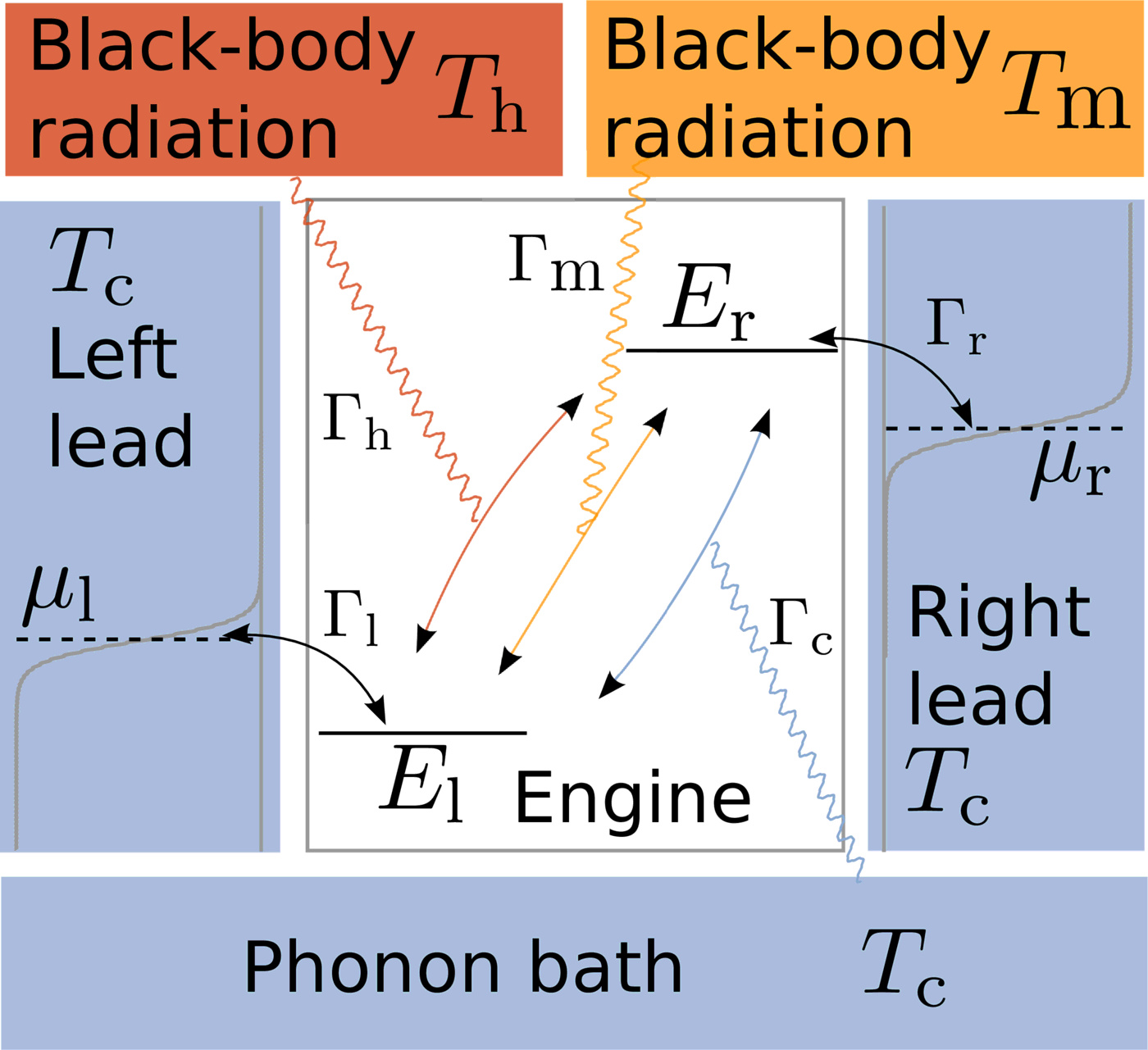 | Figure 1 Figure 1. Sketch of the studied photoelectric device. The device consists of two single-level quantum dots (in white) connected to two leads (in blue) at temperature $T_c$ and at different chemical potentials $\mu_r$ and $\mu_l$. The electron transitions between left and right quantum dots are induced either by photons from black-body radiation at temperature $T_h$(in red) or $T_m$ (in orange), or by phonons at temperature $T_c$(in blue). The arrows indicate possible electronic transitions between different energy levels and the $\Gamma$'s represent the coupling strengths with the reservoirs. |
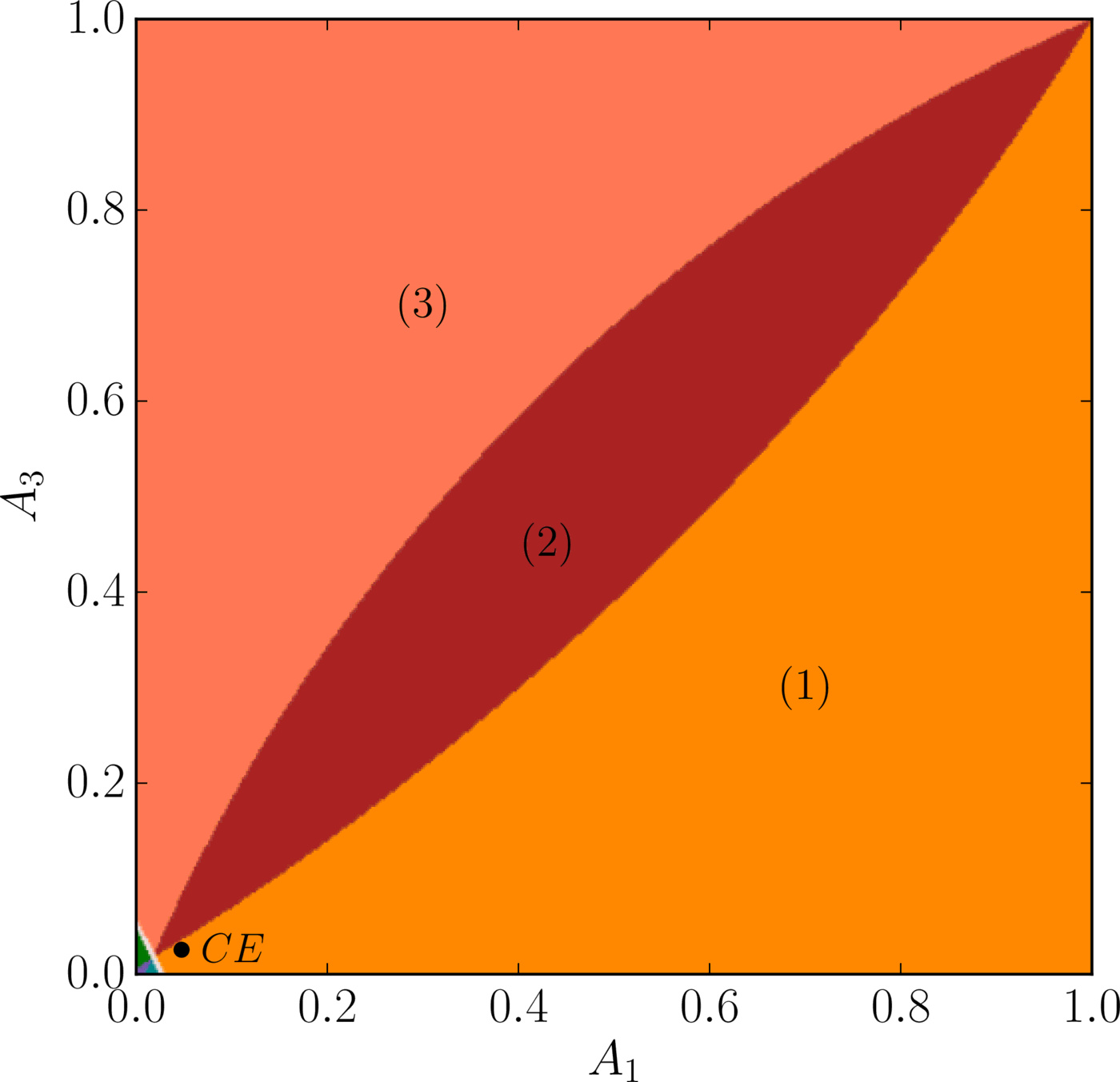 | 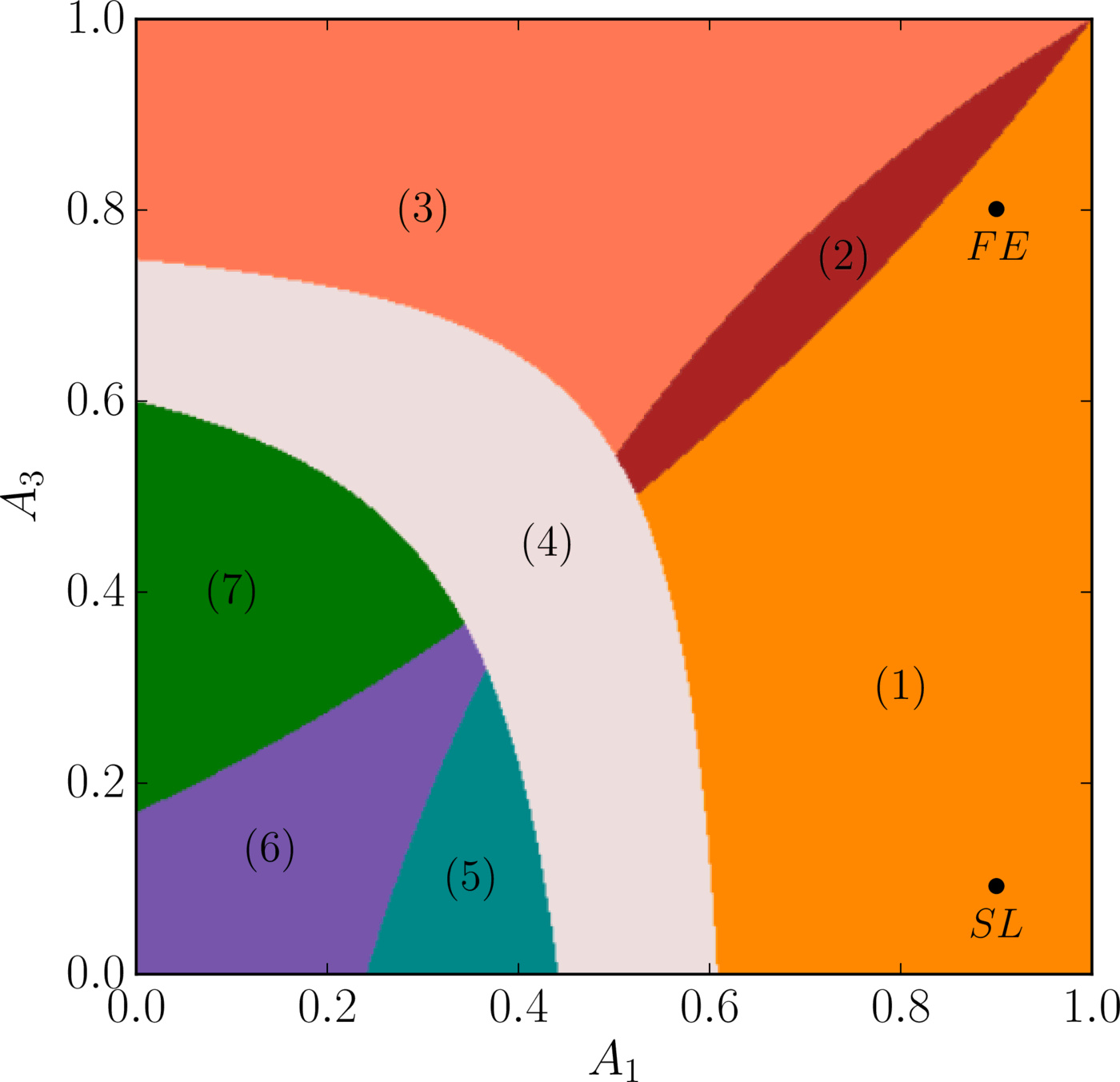 |
| (a) | (b) |
For $\gamma_1=\gamma_2=\gamma_3=0$, we retrieve the master equation for the probability $p_j(t)$ to be in state $j$ at time $t$.
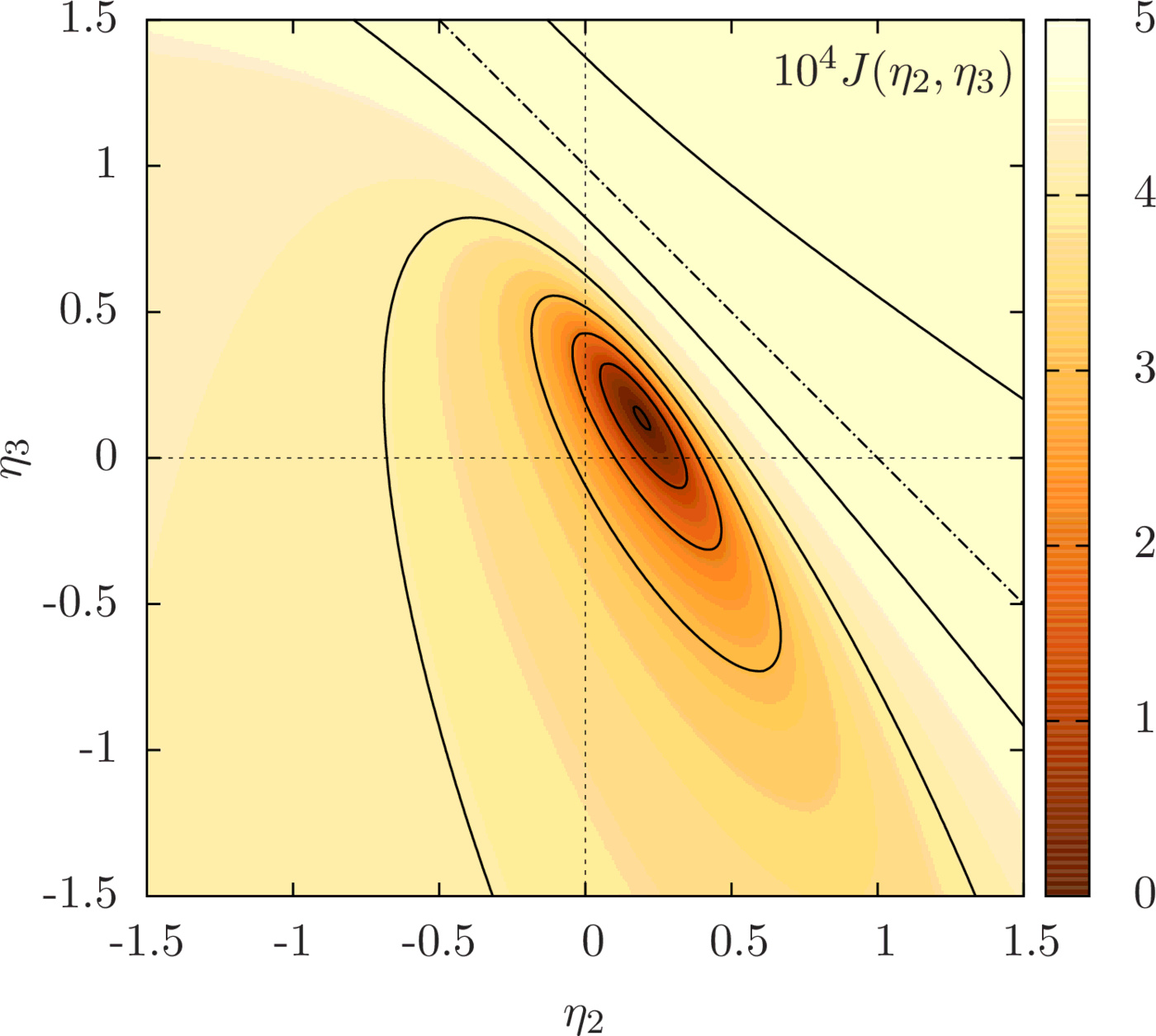 | 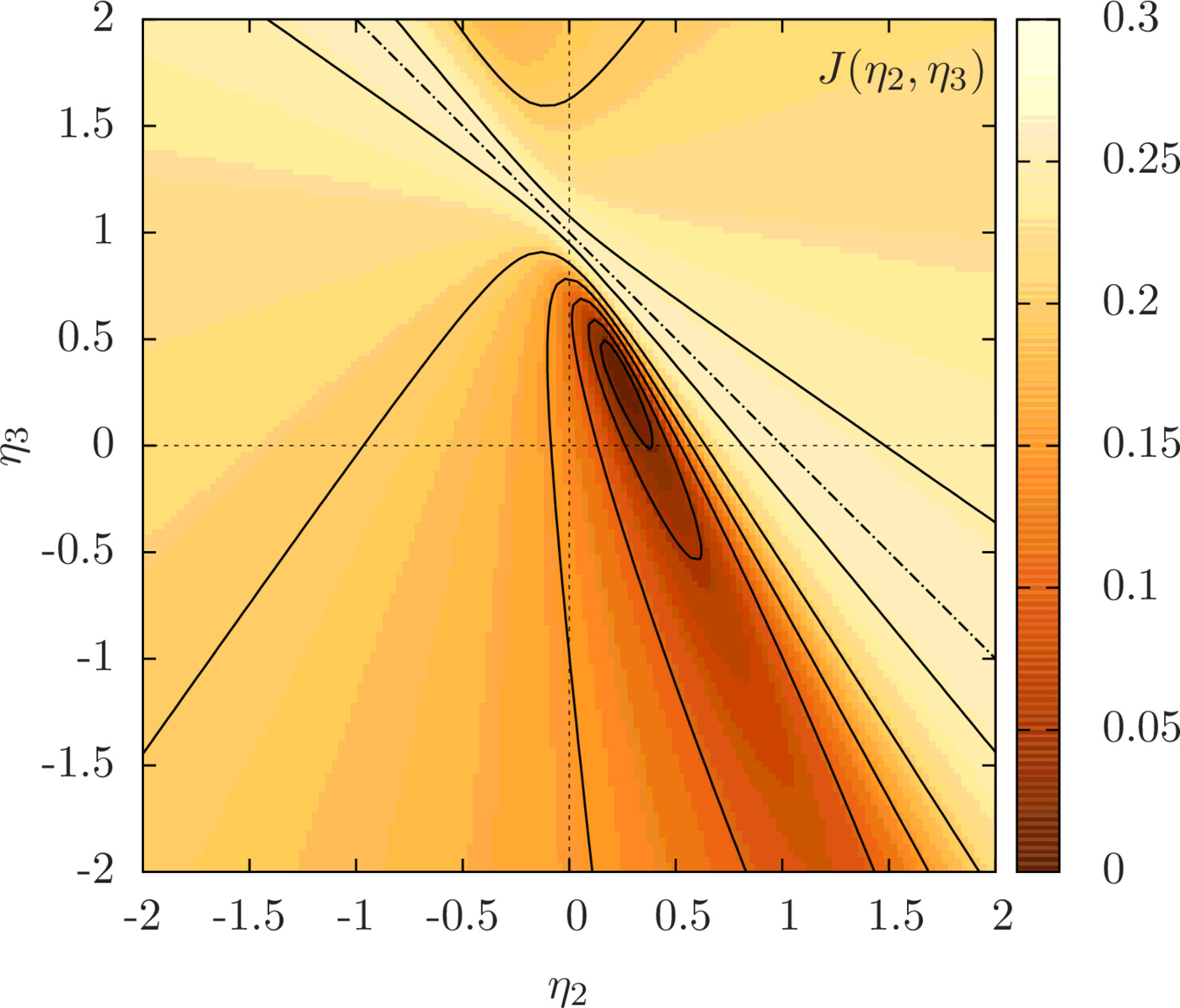 |
| (a) | (b) |
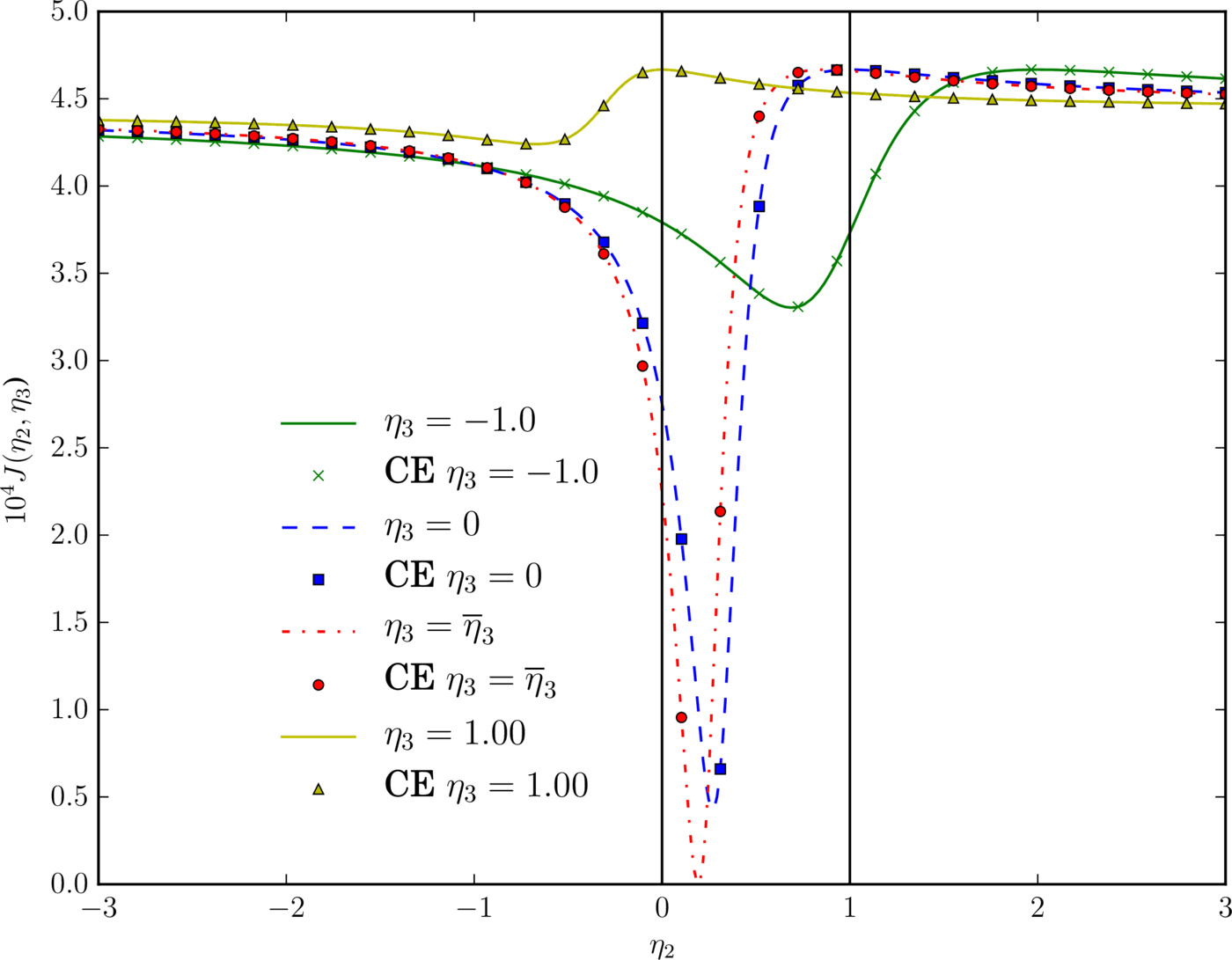 | 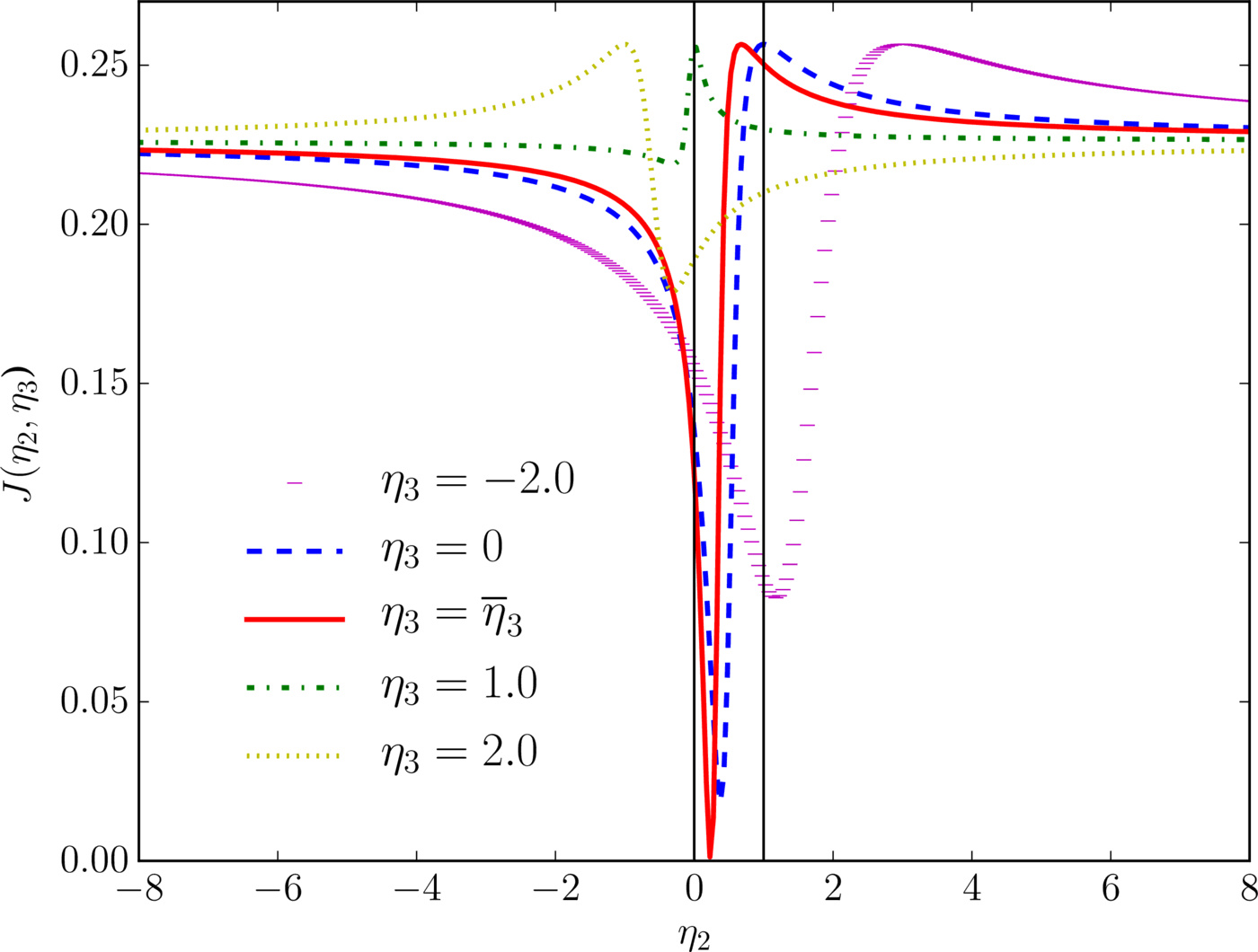 |
| (c) | (d) |
In Fig. 3(a) and 3(b) we show the efficiency LDF $J(\eta_2,\eta_3)$ in the CE and FE cases respectively. As expected, the maximum of $J$ is located on the line $\eta_2+\eta_3=1$ corresponding to the reversible efficiencies. The minimum corresponds to the macroscopic efficiencies $(\bar \eta_2,\bar \eta_3) = (0.19,0.14)$ in the CE case, and to $(\bar \eta_2,\bar \eta_3) =(0.24,0.33) $ in the FE case.
In Fig. 3(c) we verify the validity of the CE limit developed in Sec. 5.1.. The cross-sections of the efficiency LDF $J$ obtained by direct numerical computation are in perfect agreement with the same cross-sections, but obtained from Eq. (\ref{NEqPermutC}) of the CE limit. In Fig. 3(d), we also show the cross-sections of $J$, but in the FE case illustrating that all the fluctuations associated to a large efficiency becomes generically equally likely independently of the value of the other efficiency: the LDF flattens and converges to the same limit at infinity for the different cross-sections. Comparing Fig. 3(c) and 3(d), we remark that the time scale on which a large efficiency fluctuation disappears is much longer in the CE case than in the FE case.
Finally, we comment on the effect of the contraction of Eq. (\ref{minJc}) on the statistics of the remaining efficiency. This situation corresponds to ignoring the third process even though it is still influencing the machine dynamics. In Fig. 4 we provide the contracted LDF $J_{{\mathrm{ct}}}(\eta_2)$. It displays the generic shape of an efficiency LDF excepted that no constraint exists on the position of the maximum, e.g. it is below $\bar{\eta}_2$ in the FE case. This would be forbidden by the laws of thermodynamics in a machine with only two processes, but it is allowed whenever an additional process has been ignored in the description of the machine. Logically, when the ignored process is weakly irreversible as in the SL case of Fig. (4)b, the maximum of the efficiency LDF must be located close to the reversible efficiency: in the limit of a vanishing affinity for the ignored process, we retrieve the usual efficiency fluctuations of a machine with only two processes for which the reversible efficiency is the least likely.
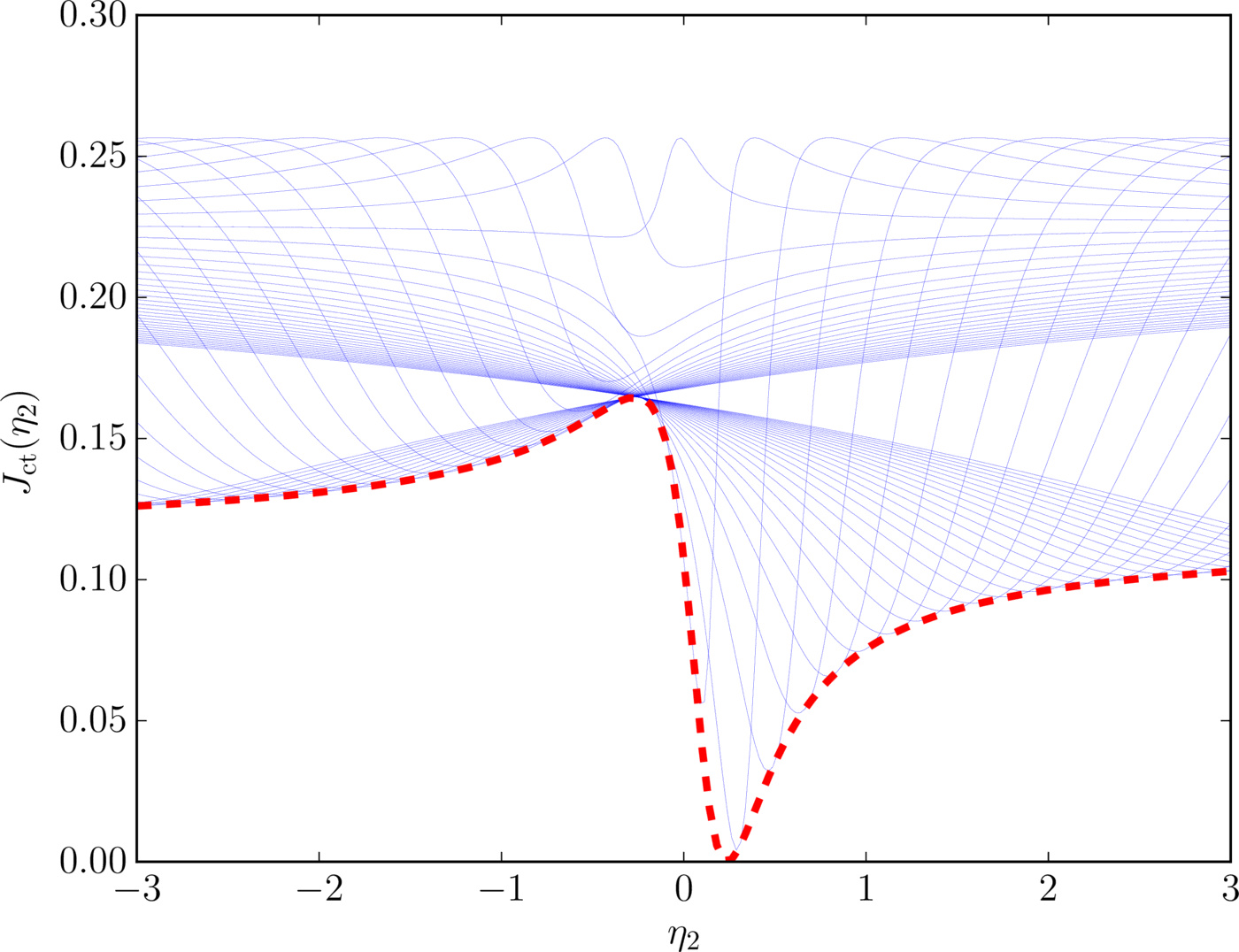 | 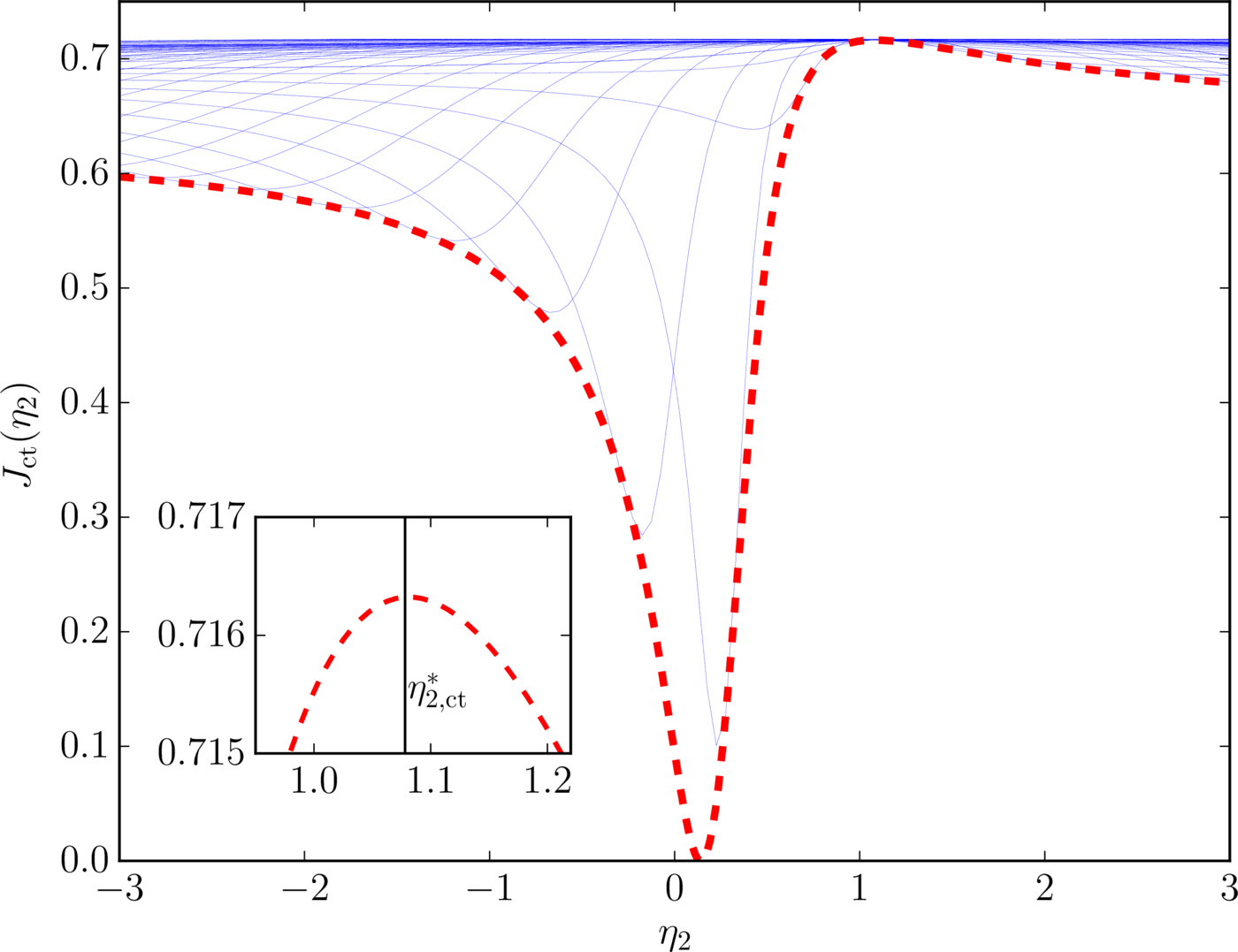 |
| (a) | (b) |
Conclusion
In this paper we focused on complex machines displaying not one, but several goals. For each goal we introduced an efficiency, paying attention to thermodynamic consistency. Our motivation was twofold: first, stochastic machines with several goals may exist in nature. Second, if two different goals exist, one may affect the efficiency of the other one. We interpreted this as a loss in a machine with a single goal and analyzed the consequences of unknown losses on the efficiency statistics.
In these two cases, we described the general properties of the large deviation function of the efficiency, using the fluctuation theorem and assuming the convexity of the large deviation function for the entropy production, and we provided a method to obtain the large deviation function of the efficiency from the cumulant generating function of the entropy production. This work extends the recent results of Refs. [24,25,27] on stochastic efficiency to the case of machines with more than two processes. In this case we confirmed that the minimum of the large deviation function of the efficiency is still given by the macroscopic efficiencies defined as the ratio of mean entropy productions, and the maximum is still connected to an entropy production minimum. However, in the case of a machine with unknown losses, the least likely efficiency is reached for the most likely trajectories conditioned on the reversibility of the input and output processes.
In the close to equilibrium limit we characterized the large deviation function of the efficiency using the response coefficient of the machine only (or equivalently using the entropy productions correlation functions). In this limit, we derived exactly the contracted large deviation function of the efficiency and found similarities with the efficiency fluctuations of a machine with only two processes. We support all our results by considering a simplified model of photoelectric cell.
The theory developed in this paper includes the case of machines with an arbitrary number of processes: we provide in appendix 7. and 8. the most important formula in the general case. Alternatively, one may always merge the various processes into two (or three) groups, the input processes, the output processes (and the loss processes), in order to use the theory developed for machines with two (or three) processes. This procedure is particularly convenient when considering that real physical systems often involve more than two processes, see for instance Ref. [40] about an electronic circuit composed of a double quantum dot channel capacitively coupled to a quantum point contact. In this reference the measurement of nano-currents leads to non trivial interactions and additional dissipation in the device. At this point, beyond the number of processes required to model a machine, it is worth stressing that quantum coherence and destructive interference may significantly affect the fluctuations of the stochastic efficiency [41].
Acknowledgement
We acknowledge H.-J. Hilhorst for his pertinent comments on this work.
Appendix
Cumulant generating function
In this appendix we obtain the efficiency LDF from the cumulant generating function of the entropy productions in the case of an arbitrary number of processes $N$. We emphasize that this method can also be used to obtain the contracted LDF. We also remark that it is usually easier to compute numerically the efficiency LDFs using this method.
The CGF and LDF for entropy productions are related by a Legendre transform \begin{multline} I(\sigma_{1},\sigma_{2},\ldots,\sigma_{N})\\ =\max_{\gamma_{1},\gamma_{2},\ldots,\gamma_{N}}\Big[\sum_{i=1}^{N}\gamma_{i}\sigma{i}-\phi(\gamma_{1},\gamma_{2},\ldots,\gamma_{N})\Big]. \end{multline} We have defined the efficiencies as $\eta_i =-\sigma_i / \sigma_1$ with $i=2,\ldots ,N$ and we write now \begin{multline} I(\sigma_{1},-\eta_2\sigma_{1},-\eta_3\sigma_{1},\ldots,-\eta_N\sigma_{1}) \\ =\max_{\gamma_{1},\gamma_{2},\ldots,\gamma_{N}}\Big[(\gamma_{1}-\sum_{i=2}^N\gamma_{i}\eta_i)\sigma_{1}-\phi(\gamma_{1},\gamma_{2},\ldots\gamma_{N})\Big] \end{multline} and the minimization of Eq. (\ref{MinJ}) gives \begin{multline} J(\eta_2,\eta_3,\ldots,\eta_N)\\ =\min_{\sigma_{1}}\max_{\gamma_{1},\gamma_{2},\ldots,\gamma_{N}}\Big[(\gamma_{1}-\sum_{i=2}^N\gamma_{i}\eta_i)\sigma_{1}-\phi(\gamma_{1},\gamma_{2},\ldots,\gamma_{N})\Big]. \end{multline} We set $ \gamma = \gamma_{1}-\sum_{i=2}^N\gamma_{i}\eta_i $ to obtain \begin{multline} J(\eta_2,\eta_3,\ldots,\eta_N) =\min_{\sigma_{1}}\max_{\gamma}\bigg\{\gamma\sigma_{1} \\ +\max_{\gamma_{2},\ldots,\gamma_{N}}\Big[-\phi(\gamma+\sum_{i=2}^N\gamma_{i}\eta_i,\gamma_{2},\ldots,\gamma_N)\Big]\bigg\}. \end{multline} We now define the function \begin{eqnarray} f_{\eta_2,\ldots,\eta_N}(\gamma) &=&-\max_{\gamma_{2},\ldots,\gamma_N}\Big\{-\phi(\gamma+\sum_{i=2}^N\gamma_{i}\eta_i,\gamma_{2},\ldots,\gamma_N)\Big\} \nonumber \\ &=&\min_{\gamma_{2},\ldots,\gamma_N} \phi(\gamma+\sum_{i=2}^N\gamma_{i}\eta_i,\gamma_{2},\ldots,\gamma_N) \label{fetaalph} \end{eqnarray} and its Legendre transform \begin{equation} \mathcal{F}_{\eta_2,\ldots,\eta_N}(\sigma_{1})= \max_{\gamma}\Big\{\gamma\sigma_{1}-f_{\eta_2,\ldots,\eta_N}(\gamma)\Big\}. \end{equation} Then the efficiency LDF can be rewritten \begin{align} J(\eta_2,\eta_3,\ldots,\eta_N)&=\min_{\sigma_{1}}\max_{\gamma}\Big\{\gamma \sigma_{1}-f_{\eta_2,\ldots,\eta_N}(\gamma)\Big\} \nonumber \\ &=\min_{\sigma_{1}}\mathcal{F}_{\eta_2,\ldots,\eta_N}(\sigma_{1}) \nonumber \\ &=-\max_{\sigma_{1}}\Big\{-\mathcal{F}_{\eta_2,\ldots,\eta_N}(\sigma_{1}) \Big\} \nonumber \\ &= -f_{\eta_2,\ldots,\eta_N}(0). \end{align} Using Eq. (\ref{fetaalph}), we conclude that \begin{equation} J(\eta_2,\eta_3,\ldots,\eta_N)=-\min_{\gamma_{2},\ldots,\gamma_{N}} \phi\left(\sum_{i=2}^N\gamma_{i}\eta_i,\gamma_{2},\ldots,\gamma_{N}\right). \end{equation}
Least likely efficiency
In this appendix we use the fluctuation theorem to prove some properties of the efficiency LDF in the general case of a machine with arbitrary driving cycle and with $N$ processes contributing to the total entropy production.
Along a level line of the entropy productions LDF, the total differential of $I$ vanishes, \begin{align} \mathrm{d} I &= \sum_{i=1}^N { \mathchoice {\dfrac{\partial{I}}{\partial{\sigma_i}}} {\dfrac{\partial{I}}{\partial{\sigma_i}}} {\frac{\partial{I}}{\partial{\sigma_i}}} {\frac{\partial{I}}{\partial{\sigma_i}}}}\mathrm{d} \sigma_i \\ &=\mathrm{d} \sigma_1 \left( { \mathchoice {\dfrac{\partial{I}}{\partial{\sigma_1}}} {\dfrac{\partial{I}}{\partial{\sigma_1}}} {\frac{\partial{I}}{\partial{\sigma_1}}} {\frac{\partial{I}}{\partial{\sigma_1}}}} +\sum_{i=2}^N { \mathchoice {\dfrac{\partial{I}}{\partial{\sigma_i}}} {\dfrac{\partial{I}}{\partial{\sigma_i}}} {\frac{\partial{I}}{\partial{\sigma_i}}} {\frac{\partial{I}}{\partial{\sigma_i}}}} \mathchoice {\dfrac{\mathrm{d} \sigma_i}{\mathrm{d} \sigma_1}} {\dfrac{\mathrm{d} \sigma_i}{\mathrm{d} \sigma_1}} {\frac{\mathrm{d} \sigma_i}{\mathrm{d} \sigma_1}} {\frac{\mathrm{d} \sigma_i}{\mathrm{d} \sigma_1}}\right) \\ &= 0. \end{align} At the origin we have $\eta_i^*=-\mathrm{d} \sigma_i/\mathrm{d} \sigma_1$ with $i=2,\ldots,N$ where the $\eta_i^*$ are defined by $J(\eta_2^*,\ldots,\eta_N^*)= I(0,\ldots,0)$. So, \begin{equation} \sum_{i=2}^N { \mathchoice {\dfrac{\partial{I}}{\partial{\sigma_i}}} {\dfrac{\partial{I}}{\partial{\sigma_i}}} {\frac{\partial{I}}{\partial{\sigma_i}}} {\frac{\partial{I}}{\partial{\sigma_i}}}}\bigg|_0\left( { \mathchoice {\dfrac{\partial{I}}{\partial{\sigma_1}}} {\dfrac{\partial{I}}{\partial{\sigma_1}}} {\frac{\partial{I}}{\partial{\sigma_1}}} {\frac{\partial{I}}{\partial{\sigma_1}}}}\bigg|_0\right)^{-1} \eta_i^* = 1. \label{ConstOnLLEFF} \end{equation} We may repeat the arguments for the machine with the time-reversed driving cycle. We denote $\hat{I}(\sigma_1,\ldots,\sigma_N)$ the entropy productions LDF of this new machine, and the efficiency LDF $\hat{J}(\eta_2,\ldots,\eta_N)$. If we define $\hat{\eta_i}^*$ by $\hat{J}(\hat{\eta}_2^*,\ldots,\hat{\eta}_N^*)= \hat{I}(0,\ldots,0)$, we have as above \begin{equation} \sum_{i=2}^N { \mathchoice {\dfrac{\partial{\hat{I}}}{\partial{\sigma_i}}} {\dfrac{\partial{\hat{I}}}{\partial{\sigma_i}}} {\frac{\partial{\hat{I}}}{\partial{\sigma_i}}} {\frac{\partial{\hat{I}}}{\partial{\sigma_i}}}}\bigg|_0\left( { \mathchoice {\dfrac{\partial{\hat{I}}}{\partial{\sigma_1}}} {\dfrac{\partial{\hat{I}}}{\partial{\sigma_1}}} {\frac{\partial{\hat{I}}}{\partial{\sigma_1}}} {\frac{\partial{\hat{I}}}{\partial{\sigma_1}}}}\bigg|_0\right)^{-1} \hat{\eta}_i^* = 1. \end{equation} We now use the fluctuation theorem for the entropy productions: \begin{equation}\label{FT} I(\sigma_1,\ldots,\sigma_N) - \hat{I}(-\sigma_1,\ldots,-\sigma_N) = -\sum_{i=1}^N\sigma_i. \end{equation} Taking the partial derivatives of this equation at origin yields \begin{equation}\label{derivativeFT} { \mathchoice {\dfrac{\partial{I}}{\partial{\sigma_i}}} {\dfrac{\partial{I}}{\partial{\sigma_i}}} {\frac{\partial{I}}{\partial{\sigma_i}}} {\frac{\partial{I}}{\partial{\sigma_i}}}} \bigg|_0+ { \mathchoice {\dfrac{\partial{\hat{I}}}{\partial{\sigma_i}}} {\dfrac{\partial{\hat{I}}}{\partial{\sigma_i}}} {\frac{\partial{\hat{I}}}{\partial{\sigma_i}}} {\frac{\partial{\hat{I}}}{\partial{\sigma_i}}}}\bigg|_0 = -1 \quad \text{with} \quad i \in \{1,\ldots,N\}. \end{equation} So, the least likely efficiencies of the machine with the time-reversed driving cycle are connected to those of the original machine. More specifically, for stationary machines or machines operating under time-symmetric driving for which $I(\sigma_1,\ldots,\sigma_N) = \hat{I}(\sigma_1,\ldots,\sigma_N)$, the least likely efficiencies satisfy the same constraint as the reversible efficiencies: \begin{equation} \sum_{i=2}^N \eta_i^* = 1, \end{equation} following from Eqs. (\ref{ConstOnLLEFF}) and (\ref{derivativeFT}).
Furthermore evaluating the fluctuation theorem (\ref{FT}) at null entropy production, we have \begin{multline} I(\sigma_1,-\bar{\eta}_{2\text{ rev}}\sigma_1,\ldots,-\bar{\eta}_{N\text{ rev}}\sigma_1) \\ = \hat{I}(-\sigma_1,\bar{\eta}_{2\text{ rev}}\sigma_1,\ldots,\bar{\eta}_{N\text{ rev}}\sigma_1). \end{multline} which after minimization over $\sigma_1$ implies that the forward and reversed efficiency LDF have the same values at reversible efficiencies, \begin{equation} J(\bar{\eta}_{2\text{ rev}},\ldots,\bar{\eta}_{N\text{ rev}}) = \widehat{J}(\bar{\eta}_{2\text{ rev}},\ldots,\bar{\eta}_{N\text{ rev}}). \label{SameValueAtRevEff} \end{equation} And still from (\ref{FT}) evaluated at the origin, we have $I(0,\ldots,0)= \widehat{I}(0,\ldots,0) $ , so the maximun of the forward and reversed efficiency LDF have the same value \begin{equation} J(\eta_2^*,\ldots,\eta_N^*)=\widehat{J}(\widehat{\eta}_2^*,\ldots,\widehat{\eta}_N^*). \label{SameMaxValue} \end{equation} Let us emphasize that Eqs. (\ref{SameValueAtRevEff}) and (\ref{SameMaxValue}) merge into the same equation for stationary machines or machines operating under time-symmetric driving since the least likely efficiencies become the reversible efficiencies.
References
- N.G. Van Kampen. Stochastic Processes in Physics and Chemistry. North-Holland Personal Library, 3rd edition, 2007.
- H. Risken. The Fokker-Planck equation. Springer, 1989.
- Crispin Gardiner. Handbook of Stochastic Methods: for Physics, Chemistry and the Natural Sciences. Springer, 2004.
- C. Van den Broeck. Stochastic thermodynamics. Selforganisation by Nonlinear Irreversible Processes, pages 57–61, 1985.
- C.Y. Mou, J.L Luo, and G. Nicolis. Stochastic thermodynamics of nonequilibrium steady states in chemical reaction systems. J. Chem. Phys., 84(12):7011–7017, 1986.
- C. Van den Broeck and M. Esposito. Ensemble and trajectory thermodynamics: A brief introduction. Phys. A, 418(0):6–16, 2014.
- U. Seifert. Stochastic thermodynamics, fluctuation theorems and molecular machines. Rep. Prog. Phys., 75(12):126001, 2012.
- C. Jarzynski. Nonequilibrium equality for free energy differences. Phys. Rev. Lett., 78(14):2690–2693, 1997.
- K. Sekimoto. Langevin equation and thermodynamics. Prog. of Theo. Phys., 130:17, 1998.
- K. Sekimoto. Stochastic Energetics. Lect. Notes Phys. 799. Springer, Berlin Heidelberg, 2010.
- U. Seifert. Entropy production along a stochastic trajectory and an integral fluctuation theorem. Phys. Rev. Lett., 95(4):040602, 2005.
- I. Prigogine. Introduction to Thermodynamics of Irreversible Processes. John Wiley and Sons, New York, 2nd edition, 1955.
- H. B. Callen. Thermodynamics and an Introduction To Thermostatistics. John Wiley and Sons, Inc, 2nd edition, 1985.
- G. Nicolis and I. Prigogine. Self-Organization in Nonequilibrium Systems: From Dissipative Structures to Order through Fluctuations. 1977.
- G.N. Bochkov and Yu.E. Kuzovlev. Nonlinear fluctuation-dissipation relations and stochastic models in nonequilibrium thermodynamics: I. generalized fluctuation-dissipation theorem. Phys. A, 106(3):443 – 479, 1981.
- D. J. Evans and D. J. Searles. Equilibrium microstates which generate second law violating steady states. Phys. Rev. E, 50:1645–1648, 1994.
- G. Gallavotti and E. G. D. Cohen. Dynamical ensembles in nonequilibrium statistical mechanics. Phys. Rev. Lett., 74(14):2694–2697, 1995.
- K. Kurchan. Fluctuation theorem for stochastic dynamics. J. Phys. A: Math. Gen., 31(16):3719, 1998.
- G. E. Crooks. Path-ensemble averages in systems driven far from equilibrium. Phys. Rev. E, 61(3):2361–2366, 2000.
- G. Bulnes Cuetara, M. Esposito, and A. Imparato. Exact fluctuation theorem without ensemble quantities. Phys. Rev. E, 89:052119, May 2014.
- N. A. Sinitsyn. Fluctuation relation for heat engines. J. Phys. A: Math. Theor., 44(40):405001, 2011.
- Michele Campisi. Fluctuation relation for quantum heat engines and refrigerators. J. Phys. A: Math. Theor., 47(24):245001, 2014.
- Michele Campisi, Jukka Pekola, and Rosario Fazio. Nonequilibrium fluctuations in quantum heat engines: theory, example, and possible solid state experiments. New Journal of Physics, 17(3):035012, 2015.
- G. Verley, T. Willaert, C. Van den Broeck, and M. Esposito. The unlikely carnot efficiency. Nat. Comm., 5(4721), 2014.
- G. Verley, T. Willaert, C. Van den Broeck, and M. Esposito. Universal theory of efficiency fluctuations. Phys. Rev. E, 90:052145, 2014.
- M. Polettini, G. Verley, and M. Esposito. Efficiency statistics at all times: Carnot limit at finite power. Phys. Rev. Lett., 114:050601, 2015.
- T. R. Gingrich, G. M. Rotskoff, S. Vaikuntanathan, and P. L. Geissler. Efficiency and large deviations in time-asymmetric stochastic heat engines. New J. Phys., 16(10):102003, 2014.
- Karel Proesmans and Christian Van den Broeck. Stochastic efficiency: five case studies. New Journal of Physics, 17(6):065004, 2015.
- Karel Proesmans, Cedric Driesen, Bart Cleuren, and Christian Van den Broeck. Efficiency of single-particle engines. Phys. Rev. E, 92:032105, Sep 2015.
- K. Proesmans, B. Cleuren, and C. Van den Broeck. Stochastic efficiency for effusion as a thermal engine. Europhys. Lett., 109(2):20004, 2015.
- I. A. Martinez, E. Roldan, L. Dinis, D. Petrov, J. M. R. Parrondo, and R. Rica. Brownian Carnot engine. Nat. Phys., 2015.
- Francesco Mazza, Riccardo Bosisio, Giuliano Benenti, Vittorio Giovannetti, Rosario Fazio, and Fabio Taddei. Thermoelectric efficiency of three-terminal quantum thermal machines. New Journal of Physics, 16(8):085001, 2014.
- B. Cleuren, B. Rutten, and C. Van den Broeck. Cooling by heating: Refrigeration powered by photons. Phys. Rev. Lett., 108:120603, Mar 2012.
- B. Rutten, M. Esposito, and B. Cleuren. Reaching optimal efficiencies using nanosized photoelectric devices. Phys. Rev. B, 80:235122, Dec 2009.
- A. Bejan. Advanced Engineering Thermodynamics. Wiley, 2006.
- H. Touchette. The large deviation approach to statistical mechanics. Phys. Rep., 478:1–69, 2009.
- Ofer Zeitouni Amir Dembo. Large Deviations Techniques and Applications. Springer, 1998.
- M. Esposito, U. Harbola, and S. Mukamel. Nonequilibrium fluctuations, fluctuation theorems, and counting statistics in quantum systems. Rev. Mod. Phys., 81:1665–1702, Dec 2009.
- Eric Jones, Travis Oliphant, Pearu Peterson, et al. SciPy: Open source scientific tools for Python, 2001–today.
- Gregory Bulnes Cuetara and Massimiliano Esposito. Double quantum dot coupled to a quantum point contact: a stochastic thermodynamics approach. New Journal of Physics, 17(9):095005, 2015.
- Massimiliano Esposito, Maicol A. Ochoa, and Michael Galperin. Efficiency fluctuations in quantum thermoelectric devices. Phys. Rev. B, 91:115417, Mar 2015.